Autonomous region in Italy
| Sicily
Sicilia (Italian) Sicilia (Sicilian) | |
|---|---|
| Autonomous region | |
 Flag Flag Coat of arms Coat of arms | |
| Anthem: Madreterra | |
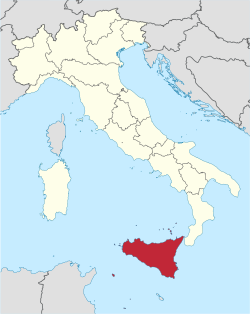 | |
| Coordinates: 37°30′N 14°00′E / 37.5°N 14°E / 37.5; 14 | |
| Country | |
| Capital | Palermo |
| Government | |
| • President | Renato Schifani (FI) |
| Area | |
| • Total | 25,832 km (9,974 sq mi) |
| Population | |
| • Total | 4,785,338 |
| • Density | 190/km (480/sq mi) |
| Demonym(s) | English: Sicilian Italian: Siciliano (man) Italian: Siciliana (woman) |
| Citizenship | |
| • Italian | 98% |
| GDP | |
| • Total | €88.767 billion (2021) |
| Time zone | UTC+1 (CET) |
| • Summer (DST) | UTC+2 (CEST) |
| ISO 3166 code | IT-82 |
| HDI (2021) | 0.847 very high · 21st of 21 |
| NUTS Region | ITG |
| Website | www |
Sicily (Italian: Sicilia, Italian: [siˈtʃiːlja] ; Sicilian: Sicilia, Sicilian: [sɪˈ(t)ʃiːlja] ), officially the Sicilian Region (Italian: Regione siciliana), is an island in the central Mediterranean Sea, south of the Italian Peninsula in continental Europe and is one of the 20 regions of Italy. With 4.8 million inhabitants, including 1.3 million in and around the capital city of Palermo, it is the most populous island in the Mediterranean Sea and also the largest island in the Mediteranean. It is named after the Sicels, who inhabited the eastern part of the island during the Iron Age. Sicily has a rich and unique culture in arts, music, literature, cuisine, and architecture. Its most prominent landmark is Mount Etna, the tallest active volcano in Europe, and one of the most active in the world, currently 3,357 m (11,014 ft) high. The island has a typical Mediterranean climate. It is separated from Calabria by the Strait of Messina. It is one of the five Italian autonomous regions and is generally considered part of Southern Italy.
The earliest archaeological record of human activity on the island is from around 14,000 BC. By around 750 BC, Sicily had three Phoenician and a dozen Greek colonies along its coasts, becoming one of the centers of Magna Graecia. The Sicilian Wars of 580–265 BC were fought between the Carthaginians and Greeks, and the Punic Wars of 264–146 BC were fought between Rome and Carthage. The Roman province of Sicilia ended with the fall of the Roman Empire in the 5th century AD. Sicily was ruled during the Early Middle Ages by the Vandals, the Ostrogoths, the Byzantine Empire, and the Emirate of Sicily.
The Norman conquest of southern Italy led to the creation of the County of Sicily in 1071, that was succeeded by Kingdom of Sicily, a state that existed from 1130 until 1816 under various dynasties, and in 1816 it was unified with the Kingdom of Naples into the Kingdom of the Two Sicilies. From the 1282 Sicilian Vespers until the 1860 Expedition of the Thousand, Sicily was ruled by Aragon and then Spain, either in personal union with the crown or by a cadet branch, with the exception of a period of Savoy and then Habsburg rule in 1713–1735.
The island became part of the newly unified Italy in 1860 following the Expedition of the Thousand, an invasion led by Giuseppe Garibaldi, and a plebiscite. Sicily was given special status as an autonomous administrative division on 15 May 1946, 18 days before the 1946 Italian institutional referendum.
Geography
See also: Geology of Sicily
Sicily has a roughly triangular shape, earning it the name Trinacria.
To the north-east, it is separated from Calabria and the rest of the Italian mainland by the Strait of Messina, about 3 km (1.9 mi) wide in the north, and about 16 km (9.9 mi) wide in the southern part. The northern and southern coasts are each about 280 km (170 mi) long measured as a straight line, while the eastern coast measures around 180 km (110 mi); total coast length is estimated at 1,484 km (922 mi). The total area of the island is 25,711 km (9,927 sq mi), while the Autonomous Region of Sicily (which includes the smaller surrounding islands of Lipari, Egadi, Ustica, and Pantelleria) has an area of 27,708 km (10,698 sq mi).
The terrain of inland Sicily is mostly hilly and is intensively cultivated wherever possible. Along the northern coast, the mountain ranges of Madonie, 2,000 m (6,600 ft), Nebrodi, 1,800 m (5,900 ft), and Peloritani, 1,300 m (4,300 ft), are an extension of the mainland Apennines. The cone of Mount Etna dominates the eastern coast. In the southeast lie the lower Hyblaean Mountains, 1,000 m (3,300 ft). The mines of the Enna and Caltanissetta districts were part of a leading sulphur-producing area throughout the 19th century, but have declined since the 1950s.
Sicily and its surrounding small islands have some highly active volcanoes. This is due to Sicily being geographically on the northern edge of the African Plate. Mount Etna is the largest active volcano in Europe and casts black ash over the island with its recurrent eruptions. It stands 3,403 metres (11,165 ft) high as of September 2024. It is the highest mountain in Italy south of the Alps. Etna covers an area of 1,190 km (459 sq mi) with a basal circumference of 140 km (87 mi). This makes it the largest of the three active volcanoes in Italy, being about two and a half times the height of the next largest, Mount Vesuvius. In Greek mythology, the deadly monster Typhon was trapped under the mountain by Zeus, the god of the sky. Mount Etna is widely regarded as a cultural symbol and icon of Sicily.
The Aeolian Islands in the Tyrrhenian Sea, to the northeast of mainland Sicily form a volcanic complex.
The three volcanoes of Vulcano, Stromboli and Lipari are also active, although the last is usually dormant. Off the southern coast of Sicily, the underwater volcano of Ferdinandea, which is part of the larger Empedocles volcano, last erupted in 1831. It is located between the coast of Agrigento and the island of Pantelleria (which itself is a dormant volcano).
From a geographical perspective, also forming a part of Sicily is the Maltese Archipelago, the islands home to the republic of Malta.
The autonomous region also includes several neighbouring islands: the Aegadian Islands, the Aeolian Islands, Pantelleria and Lampedusa.
Mountains


The mountains of Sicily form a significant part of the island's diverse landscape, with Mount Etna, one of the world's most active volcanoes, being the highest and most notable peak. Other important mountain ranges include the Nebrodi, Madonie and Peloritani mountains ranges.
| Name | Height (meters) | Height (feet) |
|---|---|---|
| Mount Etna | 3,357 | 11,014 |
| Pizzo Carbonara | 1,979 | 6,493 |
| Monte Soro | 1,853 | 6,079 |
| Rocca Busambra | 1,613 | 5,292 |
| Monte San Calogero | 1,326 | 4,318 |
Rivers
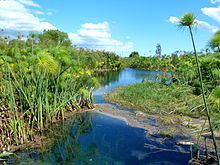
Several rivers drain the island, most of which flow through the central area and enter the sea at the south of the island. The Salso flows through parts of Enna and Caltanissetta before entering the Mediterranean Sea at the port of Licata. To the east, the Alcantara flows through the province of Messina and enters the sea at Giardini Naxos, and the Simeto, which flows into the Ionian Sea south of Catania. Other important rivers on the island are the Belice and Platani in the southwest.
| River | Length |
|---|---|
| Salso | 144 km (89 mi) |
| Simeto | 113 km (70 mi) |
| Belice | 107 km (66 mi) |
| Dittaino | 105 km (65 mi) |
| Platani | 103 km (64 mi) |
| Gornalunga | 81 km (50 mi) |
| Gela | 74 km (46 mi) |
| Salso Cimarosa | 72 km (45 mi) |
| Torto | 58 km (36 mi) |
| Irminio | 57 km (35 mi) |
| Dirillo | 54 km (34 mi) |
| Verdura | 53 km (33 mi) |
| Alcantara | 52 km (32 mi) |
| Tellaro | 49 km (30 mi) |
| Anapo | 40 km (25 mi) |
Climate
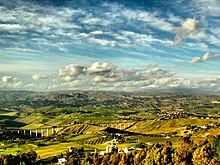
Sicily has for the most part a typical Mediterranean climate (Köppen climate classification: Csa) with mild and wet winters and hot, dry summers with changeable intermediate seasons. On the coasts, especially in the southwest, the climate is affected by the African currents and summers can be hot.
Snow falls above 900 metres, but it can fall in the hills. The interior mountains, especially Nebrodi, Madonie, and Etna, enjoy a mountain climate, with heavy snowfalls during winter. The summit of Mount Etna is usually snow-capped from October to May.
In the summer, the sirocco – the wind from the Sahara – can be felt. Rainfall is scarce, and in some provinces a water crisis can occur.
According to the Regional Agency for Waste and Water, on 10 August 1999, the weather station of Catenanuova (EN) recorded an unofficial maximum temperature of 48.5 °C (119 °F). On 11 August 2021, a new highest temperature record for Europe with a reading of 48.8 °C (119.8 °F) was set near the city of Syracuse. Total precipitation is highly variable, generally increasing with elevation. In general, the southern and southeast coast receives the least rainfall (less than 50 cm (20 in)), and the northern and northeastern highlands the most (over 100 cm (39 in)).
Flora and fauna
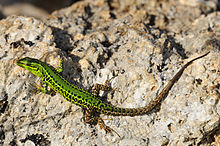
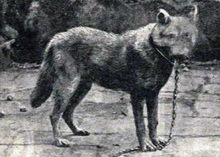
Sicily is an often-quoted example of man-made deforestation, which has occurred since Roman times when the island was turned into an agricultural region. This gradually dried the climate, leading to a decline in rainfall and the drying of rivers. The central and southwest provinces are practically devoid of forest. In Northern Sicily, there are three important forests; near Mount Etna, in the Nebrodi Mountains and in the Bosco della Ficuzza Natural Reserve near Palermo. The Nebrodi Mountains Regional Park, established on 4 August 1993 and covering 86,000 hectares (210,000 acres), is the largest protected natural area of Sicily; it contains the largest forest in Sicily, the Caronia. The Hundred Horse Chestnut (Castagno dei Cento Cavalli), in Sant'Alfio, on the eastern slopes of Mount Etna, is the largest and oldest known chestnut tree in the world at 2,000–4,000 years old.
Sicily has a wide variety of fauna. Species include the European wildcat, red fox, least weasel, pine marten, fallow deer, wild boar, crested porcupine, European hedgehog, common toad, Vipera aspis, golden eagle, peregrine falcon, Eurasian hoopoe and black-winged stilt. Roe deer were driven to extinction on the island. The Sicilian wolf (Canis lupus cristaldii) was an endemic wolf subspecies that was driven to extinction in the 20th century. During the Late Pleistocene, a species of dwarf elephant, Palaeoloxodon mnaidriensis inhabited the island, with its latest records on Sicily dating to around 20,000 years ago.
The Riserva naturale dello Zingaro (Zingaro Natural Reserve) is one of the best examples of unspoiled coastal wilderness in Sicily.
Marine Life of the Straits of Messina includes varieties of birds and marine life, including larger species such as greater flamingo and fin whale.
See also: List of endemic plants of SicilyHistory
Main article: History of SicilyThe name Sicilia was given to the Roman province in 241 BC. It is named after the Sicels, who inhabited the eastern part of the island during the Iron Age. The ancient name of the island is Trinacria (Greek Τρινακρία "having three headlands") for its triangular shape, likely a re-interpretation of earlier (Homeric) Thrinacia. The Greek name was rendered as Trīnācrĭa in classical Latin (Virgil, Ovid).
Prehistory

Humans first colonized Sicily towards the end of the Late Pleistocene, around 16,000 years ago, by people associated with the Epigravettian culture.
Discoveries of dolmens on the island (dating to the second half of the third millennium BC) seem to offer new insights into the culture of primitive Sicily. The impact of at least two influences is clear: the European one coming from the Northwest, and the Mediterranean influence of an eastern heritage.
Antiquity
Main articles: Magna Graecia, Ancient Rome, and Sicilia (Roman province)


The original classical-era inhabitants of Sicily comprised three defined groups of the ancient peoples of Italy: the Sicani, the Elymians and the Sicels. The most prominent and by far the earliest of these were the Sicani, who (Thucydides writes) arrived from the Iberian Peninsula (perhaps Catalonia). Some modern scholars, however, suggest classifying the Sicani as possibly an Illyrian tribe. Important historical evidence has been discovered in the form of cave drawings by the Sicani, dated from the end of the Pleistocene epoch around 8000 BC. The Elymians, thought to have come from the area of the Aegean Sea, became the next tribe to join the Sicanians on Sicily.
No evidence survives of warring between tribes, but the Sicanians moved eastwards when the Elymians settled in the northwest corner of the island. The Sicels are thought to have originated in Liguria; they arrived from mainland Italy in 1200 BC and forced the Sicanians to move back across Sicily and to settle in the middle of the island. Other minor Italic groups who settled in Sicily included the Ausones (Aeolian Islands, Milazzo) and the Morgetes of Morgantina.
The Phoenician settlements in the western part of the island predate the arrival of Greek colonists. From about 750 BC, the Greeks began to live in Sicily (Ancient Greek: Σικελία – Sikelia), establishing many significant settlements. The most important colony was in Syracuse; others grew up at Akragas, Selinunte, Gela, Himera and Zancle. The native Sicani and Sicel peoples became absorbed into the Hellenic culture with relative ease, and the area became part of Magna Graecia along with the coasts of the south of the Italian peninsula, which the Greeks had also colonised. Sicily had fertile soils, and the successful introduction of olives and grape vines fostered profitable trading. Greek culture significantly centered around Greek religion, and the settlers built many temples throughout Sicily, including several in the Valley of the Temples at Agrigento.
Politics on the island became intertwined with those of Greece; Syracuse became desired by the Athenians who set out on the Sicilian Expedition (415–413 BC) during the Peloponnesian War. Syracuse gained Sparta and Corinth as allies and, as a result, defeated the Athenian expedition. The victors destroyed the Athenian army and their ships, selling most of the survivors into slavery.
The Greek kingdom of Syracuse controlled most of eastern Sicily while Carthage controlled the western side. The two cultures began to clash, leading to the Greek-Punic wars (between 580 and 265 BC). The Greek states had begun to make peace with the Roman Republic in 262 BC, before the Romans sought to annex Sicily as their republic's first province. Rome attacked Carthage's holdings in Sicily in the First Punic War (264 to 241 BC) and won, making Sicily–with the exception of Syracuse–the first Roman province outside of the Italian Peninsula by 242 BC.
In the Second Punic War (218 to 201 BC), the Carthaginians attempted to recapture Sicily. Some of the Greek cities on the island who were loyal to Rome switched sides to help the Carthaginians, prompting a Roman military response. Archimedes, who lived in Syracuse, helped defend his city from Roman invasion; Roman troops killed him after they captured Syracuse in 212 BC. The Carthaginian attempt failed, and Rome became more unrelenting in its annihilation of the invaders; Roman consul M. Valerian told the Roman Senate in 210 BC that "no Carthaginian remains in Sicily".
As the Roman Republic's granary, Sicily ranked as an important province, divided into two quaestorships: Syracuse to the east and Lilybaeum to the west. Roman rule introduced the Latin language to the island, which underwent a slow process of latinisation but Sicilian culture remained largely Greek and the Greek language did not become extinct on the island, facilitating its re-hellenisation much later under the Byzantines. The prosperity of the island went into sharp decline during the governorship of Verres (73 to 71 BC). In 70 BC, the noted statesman Cicero condemned the misgovernment of Verres in his oration In Verrem.
Various groups used the island as a power base at different times: slave insurgents occupied it during the First (135−132 BC) and Second (104−100 BC) Servile Wars. Sextus Pompey had his headquarters there during the Sicilian revolt of 44 to 36 BC. Christianity first appeared in Sicily during the years following AD 200; between this time and AD 313, when Emperor Constantine the Great lifted the prohibition on Christianity, a significant number of Sicilians had become martyrs, including Agatha, Christina, Lucy, and Euplius. Christianity grew rapidly in Sicily over the next two centuries. Sicily remained a Roman province for around 700 years.
Germanic rule (469–535)
The Western Roman Empire began falling apart after the invasion of Vandals, Alans, and Sueves across the Rhine on the last day of 406. Eventually the Vandals, after roaming about western and southern Hispania (present-day Iberia) for 20 years, moved to North Africa in 429 and occupied Carthage in 439. The Franks moved south from present-day Belgium. The Visigoths moved west and eventually settled in Aquitaine in 418; the Burgundians settled in present-day Savoy in 443.
The Vandals found themselves in a position to threaten Sicily – only 100 miles away from their North African bases. After taking Carthage, the Vandals, personally led by King Gaiseric, laid siege to Palermo in 440 as the opening act in an attempt to wrest the island from Roman rule. The Vandals made another attempt to take the island one year after the 455 sack of Rome, at Agrigento, but were defeated decisively by Ricimir in a naval victory off Corsica in 456. The island remained under Roman rule until 469. The Vandals lost possession of the island 8 years later in 477 to the East Germanic tribe of the Ostrogoths, who then controlled Italy and Dalmatia. The island was returned to the Ostrogoths by payment of tribute to their king Odoacer. He ruled Italy from 476 to 488 in the name of the Byzantine (Eastern Roman) Emperor. The Vandals kept a toehold in Lilybaeum, a port on the west coast. They lost this in 491 after making one last attempt to conquer the island from this port. The Ostrogothic conquest of Sicily (and of Italy as a whole) under Theodoric the Great began in 488. The Byzantine Emperor Zeno had appointed Theodoric as a military commander in Italy. The Goths were Germanic, but Theodoric fostered Roman culture and government and allowed freedom of religion. In 461 from the age of seven or eight until 17 or 18 Theodoric had become a Byzantine hostage; he resided in the great palace of Constantinople, was favored by Emperor Leo I (r. 457–474) and learned to read, write and do arithmetic.
Byzantine period (535–827)
Further information: Byzantine Empire

After taking areas occupied by the Vandals in North Africa, Justinian I retook Italy as an ambitious attempt to recover the lost provinces in the West. The re-conquests marked an end to over 150 years of accommodating policies with tribal invaders. His first target was Sicily, leading to the Gothic War (535–554) between the Ostrogoths and the Eastern Roman Empire, also known as the Byzantine Empire. Justinian's general Belisarius was assigned to the military task. Sicily was used as a base for the Byzantines to conquer the rest of Italy, including Naples, Rome, and Milan. It took five years before the Ostrogoth capital Ravenna fell in 540. However, the new Ostrogoth king Totila counterattacked, moving down the Italian peninsula, plundering and conquering Sicily in 550. Totila was defeated and killed in the Battle of Taginae by Byzantine general Narses in 552 but Italy was in ruins.
At the time of the reconquest Greek was still the predominant language spoken on the island. Sicily was invaded by the Arab forces of Caliph Uthman in 652, but the Arabs failed to make permanent gains. They returned to Syria with their booty. Raids seeking loot continued until the mid-8th century.
The Eastern Roman Emperor Constans II moved from Constantinople to Syracuse in 660. The following year he launched an assault from Sicily against the Lombard Duchy of Benevento, which occupied most of southern Italy. Rumors that the capital of the empire was to be moved to Syracuse probably cost Constans his life, as he was assassinated in 668. His son Constantine IV succeeded him. A brief usurpation in Sicily by Mezezius was quickly suppressed by this emperor. Contemporary accounts report that the Greek language was widely spoken on the island during this period. In 740 Emperor Leo III the Isaurian transferred Sicily from the jurisdiction of the church of Rome to that of Constantinople, placing the island within the eastern branch of the Church.
In 826 Euphemius, the Byzantine commander in Sicily, having apparently killed his wife, forced a nun to marry him. Emperor Michael II caught wind of the matter and ordered general Constantine to end the marriage and cut off Euphemius' head. Euphemius rose up, killed Constantine, and then occupied Syracuse; he, in turn, was defeated and driven out to North Africa. He offered the rule of Sicily to Ziyadat Allah, the Aghlabid Emir of Tunisia, in return for a position as a general and a place of safety. A Muslim army was then sent to the island consisting of Arabs, Berbers, Cretans, and Persians.
The Muslim conquest of Sicily was a see-saw affair and met with fierce resistance. It took over a century for Byzantine Sicily to be conquered; the largest city, Syracuse, held out until 878 and the Greek city of Taormina fell in 962. It was not until 965 that all of Sicily was conquered by the Arabs. In the 11th-century Byzantine armies carried out a partial reconquest of the island under George Maniakes, but it was their Norman mercenaries who would eventually complete the island's reconquest at the end of the century.
Arab period (827–1091)
Main article: Emirate of Sicily

The Arabs initiated land reforms, which increased productivity and encouraged the growth of smallholdings, undermining the dominance of the latifundia. The Arabs further improved irrigation systems. The language spoken in Sicily under Arab rule was Siculo-Arabic and Arabic influence is present in some Sicilian words today. Although long extinct in Sicily, the language has developed into what is now the Maltese language on the islands of Malta today.
A description of Palermo was given by Ibn Hawqal, an Arab merchant who visited Sicily in 950. A walled suburb, called the Al-Kasr (the palace), is the centre of Palermo to this day, with the great Friday mosque on the site of the later Roman cathedral. The suburb of al-Khalisa (modern Kalsa) contained the Sultan's palace, baths, a mosque, government offices, and a private prison. Ibn Hawqal estimated there were 7,000 butchers trading in 150 shops. The Muslim rule introduced lemons, oranges and sugar cane, as well as cotton and mulberries for sericulture, and introduced the Qanat to improve irrigation systems for agriculture. Around 1050, the western half of Sicily was ethnically and culturally distinct from central and eastern Sicily. During this time, there was also a small Jewish presence in Sicily, evidence seen in the catacombs discovered on the island.
Palermo was initially ruled by the Aghlabids; later it was the centre of the Emirate of Sicily, which was under the nominal suzerainty of the Fatimid Caliphate. During the reign of this dynasty revolts by Byzantine Sicilians continuously occurred especially in the east where Greek-speaking Christians predominated. Parts of the island were re-occupied before revolts were quashed. Under the Arab rule the island was divided in three administrative regions, or "vals", roughly corresponding to the three "points" of Sicily: Val di Mazara in the west; Val Demone in the northeast; and Val di Noto in the southeast. As dhimmis, that is as members of a protected class of approved monotheists, the Eastern Orthodox Christians were allowed freedom of religion, but had to pay a tax, the jizya (in lieu of the obligatory alms tax, the zakat, paid by Muslims), and were restricted from active participation in public affairs. By the 11th century, the Emirate of Sicily began to fragment as intra-dynastic quarreling fractured the Muslim government.
Norman Sicily (1038–1198)
See also: Norman conquest of southern Italy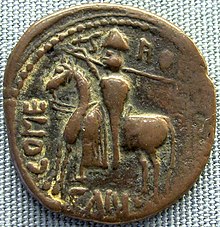
In 1038, seventy years after losing their last cities in Sicily, the Byzantines under the Greek general George Maniakes invaded the island together with their Varangian and Norman mercenaries. Maniakes was killed in a Byzantine civil war in 1043 before completing a reconquest and the Byzantines withdrew. Later the Normans invaded in 1061 and after taking Apulia and Calabria, Roger I occupied Messina with an army of 700 knights. In 1068, Roger I was victorious at Misilmeri. Most crucial was the siege of Palermo, whose fall in 1071 eventually resulted in all Sicily coming under Norman control. The conquest was completed in 1091 when they captured Noto the last Arab stronghold. Palermo continued to be the capital under the Normans. The Normans formed a small but violent ruling class. They destroyed many of the Arab towns in Sicily, and very few physical remains survive from the Arab era.
The Norman Hauteville family appreciated and admired the rich and layered culture in which they now found themselves. They also introduced into Sicily their own culture, customs, and politics from Normandy. Many Normans in Sicily adopted the habits and comportment of Muslim rulers and their Byzantine subjects in dress, language, literature, even to the extent of having palace eunuchs and, according to some accounts, a harem.
While Roger I died in 1101, his wife Adelaide ruled until 1112 when their son Roger II of Sicily came of age. Having succeeded his brother Simon as Count of Sicily, Roger II was ultimately able to raise the status of the island to a kingdom in 1130, along with his other holdings, which included the Maltese Islands and the Duchies of Apulia and Calabria.
Roger II appointed the powerful Greek George of Antioch to be his "emir of emirs" and continued the syncretism of his father. During this period, the Kingdom of Sicily was prosperous and politically powerful, becoming one of the wealthiest states in all of Europe—even wealthier than the Kingdom of England.
The court of Roger II became the most luminous centre of culture in the Mediterranean, both from Europe and the Middle East, like the multi-ethnic Caliphate of Córdoba, then only just eclipsed. This attracted scholars, scientists, poets, artists, and artisans of all kinds. Laws were issued in the language of the community to whom they were addressed in Norman Sicily, at the time when the culture was still heavily Arab and Greek. Governance was by rule of law which promoted justice. Muslims, Jews, Byzantine Greeks, Lombards, and Normans worked together fairly amicably. During this time many extraordinary buildings were constructed.
However this situation changed as the Normans imported immigrants from Normandy, England, Lombardy, Piedmont, Provence and Campania to secure the island. Linguistically, the island shifted from being one-third Greek- and two-thirds Arabic-speaking at the time of the Norman conquest to becoming fully Latinised. In terms of religion the island became completely Roman Catholic (bearing in mind that until 1054 the Churches owing allegiance to the Pope and the Patriarch of Constantinople belonged to one Church); Sicily before the Norman conquest was under the Eastern Orthodox Patriarch. After Pope Innocent III made him Papal Legate in 1098, Roger I created several Catholic bishoprics while still allowing the construction of 12 Greek-speaking monasteries (the Greek language, monasteries, and 1500 parishes continued to exist until the adherents of the Greek Rite were forced in 1585 to convert to Catholicism or leave; a small pocket of Greek-speakers still live in Messina).
-
 The cathedral of Cefalù at night
The cathedral of Cefalù at night
-
 The Cathedral of Monreale
The Cathedral of Monreale
-
 Norman castle at Aci Castello
Norman castle at Aci Castello
Kingdom of Sicily (1198–1860)
Main articles: Kingdom of Sicily and List of monarchs of Sicily

After a century, the Norman Hauteville dynasty died out; the last direct descendant and heir of Roger II, Constance, married Emperor Henry VI. This eventually led to the crown of Sicily being passed to the Hohenstaufen dynasty, who were Germans from Swabia. The last of the Hohenstaufens, Frederick II, the only son of Constance, was one of the greatest and most cultured men of the Middle Ages. His mother's will had asked Pope Innocent III to undertake the guardianship of her son. Frederick was four when at Palermo, he was crowned King of Sicily in 1198. Frederick received no systematic education and was allowed to run free in the streets of Palermo. There he picked up the many languages he heard spoken, such as Arabic and Greek, and learned some of the lore of the Jewish community. At age twelve, he dismissed Innocent's deputy regent and took over the government; at fifteen he married Constance of Aragon, and began his reclamation of the imperial crown. Subsequently, due to Muslim rebellions, Frederick II destroyed the remaining Muslim presence in Sicily, estimated at 60,000 people, moving all to the city of Lucera in Apulia between 1221 and 1226.
Conflict between the Hohenstaufen house and the Papacy led, in 1266, to Pope Innocent IV crowning the French prince Charles, count of Anjou and Provence, as the king of both Sicily and Naples.
Strong opposition to French officialdom due to mistreatment and taxation saw the local peoples of Sicily rise up, leading in 1282 to an insurrection known as the War of the Sicilian Vespers, which eventually saw almost the entire French population on the island killed. During the war, the Sicilians turned to Peter III of Aragon, son-in-law of the last Hohenstaufen king, for support after being rejected by the Pope. Peter gained control of Sicily from the French, who, however, retained control of the Kingdom of Naples. A crusade was launched in August 1283 against Peter III and the Crown of Aragon by Pope Martin IV (a pope from Île-de-France), but it failed. The wars continued until the peace of Caltabellotta in 1302, which saw Peter's son Frederick III recognized as the king of the Isle of Sicily, while Charles II was recognized as the king of Naples by Pope Boniface VIII. Sicily was ruled as an independent kingdom by relatives of the kings of Aragon until 1409 and then as part of the Crown of Aragon.
In October 1347, in Messina, Sicily, the Black Death first arrived in Europe.
Between the 15th and 18th centuries, waves of Greeks from the Peloponnese (such as the Maniots) and Arvanites migrated to Sicily in large numbers to escape persecution after the Ottoman conquest of the Peloponnese. They brought with them Eastern Orthodoxy as well as the Greek and Arvanitika languages, once again adding onto the extensive Byzantine/Greek influence.
The onset of the Spanish Inquisition in 1492 led to Ferdinand II decreeing the expulsion of all Jews from Sicily. The eastern part of the island was hit by destructive earthquakes in 1542 and 1693. Just a few years before the latter earthquake, the island was struck by a plague. The earthquake in 1693 took an estimated 60,000 lives. There were revolts during the 17th century, but these were quelled with force, especially the revolts of Palermo and Messina. North African slave raids discouraged settlement along the coast until the 19th century. The Treaty of Utrecht in 1713 saw Sicily assigned to the House of Savoy; however, this period of rule lasted only seven years, as it was exchanged for the island of Sardinia with Emperor Charles VI of the Austrian Habsburg Dynasty.
While the Austrians were concerned with the War of the Polish Succession, a Bourbon prince, Charles from Spain was able to conquer Sicily and Naples. At first Sicily was able to remain as an independent kingdom under personal union, while the Bourbons ruled over both from Naples. However, the advent of Napoleon's First French Empire saw Naples taken at the Battle of Campo Tenese and Bonapartist King of Naples was installed. Ferdinand III, the Bourbon, was forced to retreat to Sicily which he was still in control of with the help of British naval protection.
Following this, Sicily joined the Napoleonic Wars, and subsequently the British under Lord William Bentinck established a military and diplomatic presence on the island to protect against a French invasion. Sicilian volunteers joined the British military to form the Royal Sicilian Regiment, which saw action at the Battle of Maida and then transferred to Iberia. After the wars were won, Sicily and Naples formally merged as the Two Sicilies under the Bourbons. Major revolutionary movements occurred in 1820 and 1848 against the Bourbon government with Sicily seeking independence; the second of which, the 1848 revolution resulted in a short period of independence for Sicily. However, in 1849 the Bourbons retook control of the island and dominated it until 1860.
Italian unification
See also: Risorgimento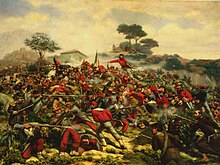
The Expedition of the Thousand led by Giuseppe Garibaldi captured Sicily in 1860, as part of the Risorgimento. The conquest started at Marsala, and native Sicilians joined him in the capture of the southern Italian peninsula. Garibaldi's march was completed with the siege of Gaeta, where the final Bourbons were expelled and Garibaldi announced his dictatorship in the name of Victor Emmanuel II of Kingdom of Sardinia. Sicily became part of the Kingdom of Sardinia after a referendum in which more than 75% of Sicily voted in favour of the annexation on 21 October 1860 (although not everyone was allowed to vote). As a result of the proclamation of the Kingdom of Italy, Sicily became part of the kingdom on 17 March 1861.
The Sicilian economy (and the wider mezzogiorno economy) remained relatively underdeveloped after the Italian unification, in spite of the strong investments made by the Kingdom of Italy in terms of modern infrastructure, and this caused an unprecedented wave of emigration. In 1894, organisations of workers and peasants known as the Fasci Siciliani protested against the bad social and economic conditions of the island, but they were suppressed in a few days.
This period was also characterized by the first contact between the Sicilian Mafia (the crime syndicate also known as Cosa Nostra) and the Italian government. The Mafia's origins are still uncertain, but it is generally accepted that it emerged in the 18th century initially in the role of private enforcers hired to protect the property of landowners and merchants from the groups of briganti who frequently pillaged the countryside and towns. The battle against the Mafia made by the Kingdom of Italy was controversial and ambiguous. The Carabinieri (the military police of Italy) and sometimes the Royal Italian Army were often involved in fights against the mafia members, but their efforts were frequently useless because of the weakness of the Italian judicial system and cooperation between the mafia and local governments.
20th and 21st centuries
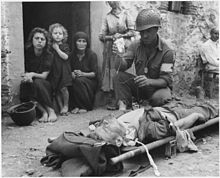
The Messina earthquake of 28 December 1908 killed more than 80,000 people.
In the 1920s, the Fascist regime began taking stronger military action, led by Cesare Mori (nicknamed the "Iron Prefect" for his iron-fisted campaigns), against the Sicilian Mafia, the first that ended with considerable success. There was an Allied invasion of Sicily during World War II starting on 10 July 1943. In preparation for the invasion, the Allies revitalised the Mafia to aid them. The invasion of Sicily contributed to the 25 July crisis; in general, the Allied victors were warmly embraced by Sicily.
In the aftermath of World War II, Italy became a Republic in 1946. Under the Constitution of Italy, Sicily is one of five regions with autonomy. Both the partial Italian land reform and special funding from the Italian government's Cassa per il Mezzogiorno (Fund for the South) from 1950 to 1984 helped the Sicilian economy. During this period, the economic and social condition of the island was generally improved due to investments in infrastructure (such as motorways and airports) and the creation of industrial and commercial areas. In the 1980s, the Mafia was weakened by another campaign led by magistrates Giovanni Falcone and Paolo Borsellino. Between 1990 and 2005, the unemployment rate fell from about 23% to 11%.
The Cosa Nostra has traditionally been the most powerful group in Sicily, especially around Palermo. A police investigation in summer 2019 also confirmed strong links between the Palermo area Sicilian Mafia and American organized crime, particularly the Gambino crime family. According to La Repubblica, "Off they go, through the streets of Passo di Rigano, Boccadifalco, Torretta and at the same time, Brooklyn, Staten Island, New Jersey. Because from Sicily to the US, the old mafia has returned."
Demographics
Main article: Sicilians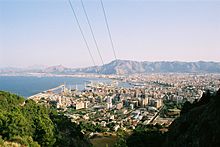
| Year | Pop. | ±% |
|---|---|---|
| 1861 | 2,409,000 | — |
| 1871 | 2,590,000 | +7.5% |
| 1881 | 2,933,000 | +13.2% |
| 1901 | 3,568,000 | +21.7% |
| 1911 | 3,812,000 | +6.8% |
| 1921 | 4,223,000 | +10.8% |
| 1931 | 3,906,000 | −7.5% |
| 1936 | 4,000,000 | +2.4% |
| 1951 | 4,486,749 | +12.2% |
| 1961 | 4,721,001 | +5.2% |
| 1971 | 4,680,711 | −0.9% |
| 1981 | 4,906,878 | +4.8% |
| 1991 | 4,966,386 | +1.2% |
| 2001 | 4,968,991 | +0.1% |
| 2011 | 5,002,904 | +0.7% |
| 2021 | 4,833,329 | −3.4% |
| 2024 | 4,785,338 | −1.0% |
| Source: ISTAT | ||
As of 2024, 4.75 million people live in Sicily, making it the fourth most populated region in Italy. In the first century after the Italian unification, Sicily had one of the most negative net migration rates among the regions of Italy because of the emigration of millions of people to Northern Italy, other European countries, North America, South America and Australia. Like the South of Italy and Sardinia, immigration to the island is very low compared to other regions of Italy because workers tend to head to Northern Italy instead, due to better employment and industrial opportunities. According to ISTAT figures from 2017, show around 175,000 immigrants out of the total 5,029,615 population; Romanians with more than 50,000 make up the most immigrants, followed by Tunisians, Moroccans, Sri Lankans, Albanians, and others mostly from Eastern Europe. As of 31 December 2020, there were 186,195 foreigners resident in the region. As in the rest of Italy, the official language is Italian and the primary religion is Roman Catholicism.
Emigration
See also: Sicilian Americans
Sicilian emigration started shortly after the Italian unification and has not stopped ever since.. After the Italian unification, Sicily, along with the entire Italian peninsula, has also been strongly marked by economic emigration. Most of the assets of the Kingdom of the Two Sicilies's former national bank, Banco delle Due Sicilie, were transferred to Piedmont. During the first decades of c, a rising number of southern Italian manufactories were driven into ruin due to high taxation imposed by the central government.
The aforementioned factors, along with a failed land reform, resulted in a never-before-seen wave of Sicilians emigrating, first to the United States between the 1880s and the 1920s, later to Northern Italy, and from the 1960s onwards also to Belgium, France, Germany, Switzerland, as well as Australia and South America.
Today, Sicily is the Italian region with the highest number of expatriates: as of 2017, 750,000 Sicilians, 14.4% of the island's population, lived abroad. For lack of employment, every year many Sicilians, especially young graduates, still leave the island to seek jobs abroad. Today, an estimated 10 million people of Sicilian origin live around the world.
Largest cities
See also: List of communes of SicilyThese are the ten largest cities of Sicily:
| Rank | Name | Pop. (2017) | Area (km) | Pop. per km |
|---|---|---|---|---|
| 1 | Palermo | 668,405 | 159 | 4,207 |
| 2 | Catania | 311,620 | 181 | 1,723 |
| 3 | Messina | 234,293 | 212 | 1,107 |
| 4 | Syracuse | 121,605 | 204 | 596 |
| 5 | Marsala | 82,802 | 242 | 343 |
| 6 | Gela | 74,858 | 277 | 270 |
| 7 | Ragusa | 73,638 | 442 | 166 |
| 8 | Trapani | 67,923 | 272 | 250 |
| 9 | Vittoria | 64,212 | 181 | 354 |
| 10 | Caltanissetta | 62,317 | 416 | 150 |
Religion
See also: Italo-Albanian Catholic Church, History of the Jews in Sicily, and History of Islam in southern Italy
As in most Italian regions, Roman Catholicism is the predominant religious denomination in Sicily, and the church still plays an important role in the lives of most people. There is also a notable small minority of Eastern-rite Byzantine Catholics which has a mixed congregation of ethnic Albanians; it is operated by the Italo-Albanian Catholic Church. Most people still attend church weekly or at least for religious festivals, and many people get married in churches. There was a wide presence of Jews in Sicily for at least 1,400 years and possibly for more than 2,000 years. Some scholars believe that the Sicilian Jewry are partial ancestors of the Ashkenazi Jews. However, much of the Jewish community faded away when they were expelled from the island in 1492. Islam was present during the Emirate of Sicily, although Muslims were also expelled. Today, mostly due to immigration to the island, there are also several religious minorities, such as Jehovah's Witnesses, Hinduism, Islam, Judaism, and Sikhism. There are also a some Evangelical Christians who live on the island. As of 2020, there are approximately 4,989,921 Roman Catholics in Sicily constituting about 99.2% of the island's population. Additionally there are also about 23,120 members of the Italo-Albanian Catholic Church also living in Sicily constituting roughly 0.5% of the population.
Politics
Main article: Politics of SicilyThe politics of Sicily takes place in a framework of a presidential representative democracy, whereby the President of Regional Government is the head of government, and of a pluriform multi-party system. Executive power is exercised by the Regional Government. Legislative power is vested in both the government and the Sicilian Regional Assembly. The capital of Sicily is Palermo.
Traditionally, Sicily votes for centre-right parties during elections. From 1943 to 1951, there was also a separatist political party called Sicilian Independence Movement (Movimento Indipendentista Siciliano, MIS). Their most successful result was at the 1946 general election, when MIS obtained 0.7% of national votes (8.8% of votes in Sicily), and four seats. However, the movement lost all their seats following the 1948 general election and the 1951 regional election. Even though it has never been formally disbanded, today the movement is no longer part of the politics of Sicily. After World War II, Sicily became a stronghold of the Christian Democracy. Sicily is now governed by a centre-right coalition. Renato Schifani is the current President and has served since 2022.
Administrative divisions
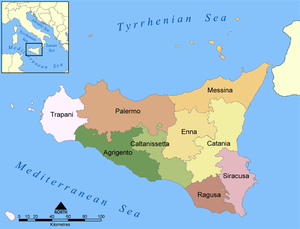
Administratively, Sicily is divided into nine provinces, each with a capital city of the same name as the province. Small surrounding islands are also part of various Sicilian provinces: the Aeolian Islands (Messina), isle of Ustica (Palermo), Aegadian Islands (Trapani), isle of Pantelleria (Trapani) and Pelagian Islands (Agrigento).
| Province | Area (km) |
Population | Density (Pop. per km) |
Number of communes |
|---|---|---|---|---|
| Agrigento | 3,042 | 453,594 | 149.1 | 43 |
| Caltanissetta | 2,128 | 271,168 | 127.4 | 22 |
| Catania | 3,552 | 1,090,620 | 307.0 | 58 |
| Enna | 2,562 | 172,159 | 67.2 | 20 |
| Messina | 3,247 | 652,742 | 201.0 | 108 |
| Palermo | 4,992 | 1,249,744 | 250.3 | 82 |
| Ragusa | 1,614 | 318,980 | 197.6 | 12 |
| Siracusa | 2,109 | 403,559 | 191.3 | 21 |
| Trapani | 2,460 | 436,240 | 177.3 | 24 |
Economy
See also: Economy of Italy
Thanks to regular growth in recent years, Sicily is the eighth largest regional economy of Italy in terms of total GDP (see List of Italian regions by GDP). A series of reforms and investments in agriculture, such as the introduction of modern irrigation systems, has made this important industry competitive. In the 1970s, some factories were opened, resulting in growth in the industrial sector. In recent years the service industry has become more important due to the opening of several shopping malls and some modest growth in financial and telecommunication activities. Tourism is an important source of income for the island, which attracts visitors due to its rich natural and historical heritage. Today Sicily is investing a large amount of money into the development of its hospitality industry, to attract even more tourism. However, Sicily continues to have a GDP per capita below the Italian average, and higher unemployment than the rest of Italy.
Agriculture

Sicily has long been noted for its fertile soil, which is the result of past volcanic eruptions. The local agriculture is also helped by the pleasant climate of the island. The main agricultural products are wheat, citrons, oranges (Arancia Rossa di Sicilia IGP), lemons, tomatoes (Pomodoro di Pachino IGP), olives, olive oil, artichokes, prickly pear (Fico d'India dell'Etna DOP), almonds, grapes, pistachios (Pistacchio di Bronte DOP) and wine. Cattle and sheep are raised. The production of cheese is particularly important thanks to the Ragusano DOP and the Pecorino Siciliano DOP. Ragusa is noted for its honey (Miele Ibleo) and chocolate (Cioccolato di Modica IGP) products.
Sicily is the third largest wine producer in Italy, after Veneto and Emilia Romagna (and Italy is the world's largest wine producer). The region is known mainly for fortified Marsala wines. In recent decades the wine industry has improved, new winemakers are experimenting with less-well-known native varieties, and Sicilian wines have become better known. The best known local variety is Nero d'Avola named after Avola, a town not far from Syracuse. Other important native varieties are: Nerello Mascalese, used to make the Etna Rosso DOC wine; Frappato, a component of the Cerasuolo di Vittoria DOCG wine; Moscato di Pantelleria (also known as Zibibbo), which is used to make different Pantelleria wines; Malvasia di Lipari, used for the Malvasia di Lipari DOC wine; and Catarratto, mostly used to make a white wine, Alcamo DOC. Furthermore, in Sicily, high-quality wines are also produced using non-native varieties like Syrah, Chardonnay and Merlot.
Sicily is also known for its liqueurs, such as Amaro Averna, produced in Caltanissetta, and the local limoncello.
Fishing is another fundamental resource for Sicily. It has important tuna, sardine, swordfish and European anchovy fisheries. Mazara del Vallo is the largest fishing centre in Sicily and one of the most important in Italy.
Industry and manufacturing


Improvements in Sicily's road system have helped to promote industrial development. The region has three important industrial districts:
- Catania Industrial District, where there are several food industries and one of the best European electronics industry centres called Etna Valley (in honour of the best known Silicon Valley) which contains offices and factories of international companies such as STMicroelectronics and Numonyx;
- Syracuse Petrochemical District with chemical industries, oil refineries and important power stations (as the innovative Archimede combined cycle power plant);
- the latest Enna Industrial District in which there are food industries.
In Palermo there are important shipyards (such as Fincantieri), mechanical factories of famous Italian companies as Ansaldo Breda, publishing and textile industries. Chemical industries are also in the Province of Messina (Milazzo) and in the Province of Caltanissetta (Gela). There are petroleum, natural gas and asphalt fields in the Southeast (mostly near Ragusa) and massive deposits of halite in Central Sicily. The Province of Trapani is one of the largest sea salt producers in Italy.
Statistics
GDP growth
Sicily's GDP (nominal and per capita) growth between 2000 and 2008 was as follows:
| 2000 | 2001 | 2002 | 2003 | 2004 | 2005 | 2006 | 2008 | |
|---|---|---|---|---|---|---|---|---|
| Gross Domestic Product (Millions of Euros) |
67,204 | 70,530 | 72,855 | 75,085 | 77,327 | 80,358 | 82,938 | 88,328 |
| GDP (PPP) per capita (Euro) |
13,479 | 14,185 | 14,662 | 15,053 | 15,440 | 16,023 | 16,531 | 17,533 |
Economic sectors
Sectors of the Sicilian economy in 2006:
| Economic activity | GDP € millions |
% sector (Sicily) |
% sector (Italy) |
|---|---|---|---|
| Agriculture, farming, fishing | 2,923.3 | 3.52% | 1.84% |
| Industry | 7,712.9 | 9.30% | 18.30% |
| Constructions | 4,582.1 | 5.52% | 5.41% |
| Commerce, hotels and restaurants, transport, services and (tele)communications | 15,159.7 | 18.28% | 20.54% |
| Financial activity and real estate | 17,656.1 | 21.29% | 24.17% |
| Other economic activities | 24,011.5 | 28.95% | 18.97% |
| VAT and other forms of taxes | 10,893.1 | 13.13% | 10.76% |
| GDP of Sicily | 82,938.6 |
Unemployment rate
The unemployment rate was 21.5% in 2018 and was one of the highest in Italy and Europe.
| Year | 2006 | 2007 | 2008 | 2009 | 2010 | 2011 | 2012 | 2013 | 2014 | 2015 | 2016 | 2017 | 2018 |
|---|---|---|---|---|---|---|---|---|---|---|---|---|---|
| Unemployment rate | 13.4% | 12.9% | 13.7% | 13.8% | 14.6% | 14.3% | 18.4% | 21.0% | 22.2% | 21.4% | 22.1% | 21.5% | 21.5% |
Transport
Roads
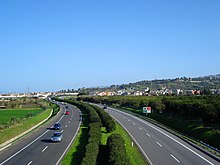

Highways have been built and expanded in the last four decades. The most prominent Sicilian roads are the motorways (known as autostrade) in the north of the island. Much of the motorway network is elevated on pillars due to the island's mountainous terrain. Other main roads in Sicily are the Strade Statali, such as the SS.113 that connects Trapani to Messina (via Palermo), the SS.114 Messina-Syracuse (via Catania) and the SS.115 Syracuse-Trapani (via Ragusa, Gela and Agrigento).
| Sign | Motorway | Length | Toll | Services |
|---|---|---|---|---|
| A18 Messina-Catania | 76 km (47 mi) | |||
| RA15 Catania's Bypass (West) | 24 km (15 mi) | Free | ||
| Motorway Catania-Siracusa | 25 km (16 mi) | Free | No | |
| A18 Siracusa-Rosolini | 40 km (25 mi) | Free | No | |
| A19 Palermo-Catania | 199 km (124 mi) | Free | ||
| A20 Palermo-Messina | 181 km (112 mi) | |||
| A29 Palermo-Mazara del Vallo | 119 km (74 mi) | Free | No | |
| A29dir Alcamo-Trapani/Marsala | 38 km (24 mi) and 44 km (27 mi) |
Free | No |
Railways
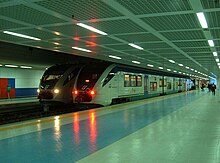


The first railway in Sicily was opened in 1863 (Palermo-Bagheria) and today all of the Sicilian provinces are served by a network of railway services, linking to most major cities and towns; this service is operated by Trenitalia. Of the 1,378 km (856 mi) of railway tracks in use, over 60% has been electrified whilst the remaining 583 km (362 mi) are serviced by diesel engines. 88% of the lines (1.209 km) are single-track and only 169 km (105 mi) are double-track serving the two main routes, Messina-Palermo (Tyrrhenian) and Messina-Catania-Syracuse (Ionian), which are the main lines of this region. Of the narrow-gauge railways the Ferrovia Circumetnea is the only one that still operates, going round Mount Etna. From the major cities of Sicily, there are services to Naples, Rome and Milan; this is achieved by the trains being loaded onto ferries which cross the Strait.
In Catania there is an underground railway service (metropolitana di Catania); in Palermo the national railway operator Trenitalia operates a commuter rail (Palermo metropolitan railway service), the Sicilian Capital is also served by 4 AMAT (Comunal Public Transport Operator) tramlines; Messina is served by a tramline.
Airports
Main article: List of airports in Sicily
Sicily has several airports that serve numerous Italian and European destinations and some extra-European.
- Catania-Fontanarossa Airport, located on the east coast, is the busiest on the island (and one of the busiest in all of Italy).
- Palermo International Airport, which is also a substantially large airport with many national and international flights.
- Trapani-Birgi Airport, a military-civil joint-use airport (third for traffic on the island). Recently the airport has seen an increase in traffic thanks to the low-cost carrier Ryanair.
- Comiso-Ragusa Airport, has recently been refurbished and re-converted from military use to a civil airport. It was opened to commercial traffic and general aviation on 30 May 2013.
- Palermo-Boccadifalco Airport is the old airport of Palermo and is currently used for general aviation and as a base for the Guardia di Finanza and police helicopters.
- NAS Sigonella Airport, it is an Italian Air Force and US Navy installation.
- Lampedusa Airport.
- Pantelleria Airport.
Ports
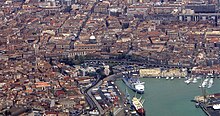
By sea, Sicily is served by several ferry routes and cargo ports, and in all major cities, cruise ships dock on a regular basis.
- Mainland Italy: Ports connecting to the mainland are Messina (route to Villa San Giovanni and Salerno), the busiest passenger port in Italy, Palermo (routes to Genoa, Civitavecchia and Naples) and Catania (route to Naples).
- Sicily's small surrounding islands: The port of Milazzo serves the Aeolian Islands, the ports of Trapani and Marsala the Aegadian Islands and the port of Porto Empedocle the Pelagie Islands. From Palermo there is a service to the island of Ustica and to Sardinia.
- International connections: From Palermo and Trapani there are weekly services to Tunisia and there is also a daily service between Malta and Pozzallo.
- Commercial and cargo ports: The port of Augusta is the fifth-largest cargo port in Italy and handles tonnes of goods. Other major cargo ports are Palermo, Catania, Trapani, Pozzallo and Termini Imerese.
- Touristic ports: Several ports along the Sicilian coast are in the service of private boats that need to moor on the island. The main ports for this traffic are in Marina di Ragusa, Riposto, Portorosa, Syracuse, Cefalù and Sciacca. In Sicily, Palermo is also a major centre for boat rental, with or without crew, in the Mediterranean.
- Fishing ports: Like all islands, Sicily also has many fishing ports. The most important is in Mazara del Vallo followed by Castellamare del Golfo, Licata, Scoglitti and Portopalo di Capo Passero.
Planned bridge
Main article: Strait of Messina BridgePlans for a bridge linking Sicily to the mainland have been discussed since 1865. Throughout the last decade, plans were developed for a road and rail link to the mainland via what would be the world's longest suspension bridge, the Strait of Messina Bridge. Planning for the project has experienced several false starts over the past few decades. On 6 March 2009, Silvio Berlusconi's government declared that the construction works for the Messina Bridge would begin on 23 December 2009, and announced a pledge of €1.3 billion as a contribution to the bridge's total cost, estimated at €6.1 billion. The plan has been criticized by environmental associations and some local Sicilians and Calabrians, concerned with its environmental impact, economic sustainability and even possible infiltrations by organized crime.
Tourism

Sicily's sunny, dry climate, scenery, cuisine, history, and architecture attract many tourists from the rest of Italy and abroad. The tourist season peaks in the summer months, although people visit the island all year round. Mount Etna, the beaches, the archaeological sites, and major cities such as Palermo, Catania, Syracuse and Ragusa are the favourite tourist destinations, but the old town of Taormina and the neighbouring seaside resort of Giardini Naxos draw visitors from all over the world, as do the Aeolian Islands, Erice, Terrasini, Castellammare del Golfo, Cefalù, Agrigento, the Pelagie Islands and Capo d'Orlando. The last features some of the best-preserved temples of the ancient Greek period. Many Mediterranean cruise ships stop in Sicily, and many wine tourists also visit the island.
Some scenes of several Hollywood and Cinecittà films were shot in Sicily. This increased the attraction of Sicily as a tourist destination.
UNESCO World Heritage Sites

There are seven UNESCO World Heritage Sites on Sicily. By the order of inscription:
- Valle dei Templi (1997) is one of the most outstanding examples of Magna Graecia art and architecture, and is one of the main attractions of Sicily as well as a national monument of Italy. The site is located in Agrigento.
- Villa Romana del Casale (1997) is a Roman villa built in the first quarter of the 4th century and located about 3 km (2 mi) outside the town of Piazza Armerina. It contains the richest, largest and most complex collection of Roman mosaics in the world.
- Aeolian Islands (2000) are a volcanic archipelago in the Tyrrhenian Sea, named after the demigod of the winds Aeolus. The Aeolian Islands are a tourist destination in the summer, and attract up to 200,000 visitors annually.
- Late Baroque Towns of the Val di Noto (2002) "represent the culmination and final flowering of Baroque art in Europe". It includes several towns: Caltagirone, Militello in Val di Catania, Catania, Modica, Noto, Palazzolo Acreide, Ragusa and Scicli.
- Necropolis of Pantalica (2005) is a large Necropolis in Sicily with over 5,000 tombs dating from the 13th to the 7th centuries BC. Syracuse is notable for its rich Greek history, culture, amphitheatres and architecture. They are situated in south-eastern Sicily.
- Mount Etna (2013) is one of the most active volcanoes in the world and is in an almost constant state of activity and generated myths, legends and naturalistic observation from Greek, Celts and Roman classic and medieval times.
- Arab-Norman Palermo and the cathedral churches of Cefalù and Monreale; includes a series of nine civil and religious structures dating from the era of the Norman kingdom of Sicily (1130–1194)

Tentative UNESCO World Heritage sites

- Taormina and Isola Bella;
- Motya and Libeo Island: The Phoenician-Punic Civilisation in Italy;
- Scala dei Turchi;
- Strait of Messina.
Archaeological sites
Because many different cultures settled, dominated or invaded the island, Sicily has a huge variety of archaeological sites. Also, some of the most notable and best preserved temples and other structures of the Greek world are located in Sicily. Here is a short list of the major archaeological sites:
- Sicels/Sicans/Elymians/Greeks: Segesta, Eryx, Cava Ispica, Thapsos, Pantalica;
- Greeks: Syracuse, Agrigento, Segesta, Selinunte, Gela, Kamarina, Himera, Megara Hyblaea, Naxos, Heraclea Minoa;
- Phoenicians: Motya, Soluntum, Marsala, Palermo;
- Romans: Piazza Armerina, Centuripe, Taormina, Palermo;
The excavation and restoration of one of Sicily's best known archaeological sites, the Valley of the Temples in Agrigento, was at the direction of the archaeologist Domenico Antonio Lo Faso Pietrasanta, Fifth Duke of Serradifalco, known in archaeological circles simply as "Serradifalco". He also oversaw the restoration of ancient sites at Segesta, Selinunte, Siracusa and Taormina.
Castles
In Sicily there are hundreds of castles, the most relevant are:
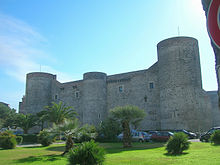


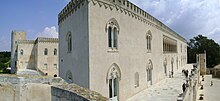
| Province | Castles | Commune |
|---|---|---|
| Caltanisetta | Castello Manfredonico | Mussomeli |
| U Cannuni | Mazzarino | |
| Castelluccio di Gela | Gela | |
| Catania | Castello Ursino | Catania |
| Castello Normanno | Adrano | |
| Castello Normanno | Paternò | |
| Castello di Aci | Aci Castello | |
| Enna | Castello di Lombardia | Enna |
| Messina | Forte dei Centri | Messina |
| Castello di Milazzo | Milazzo | |
| Castello di Federico II | Montalbano Elicona | |
| Castello di Sant'Alessio Siculo | Sant'Alessio Siculo | |
| Castello di Pentefur | Savoca | |
| Castello di Schisò | Giardini Naxos | |
| Palermo | Zisa, Palermo | Palermo |
| Castello di Caccamo | Caccamo | |
| Castello di Carini | Carini | |
| Castello dei Ventimiglia | Castelbuono | |
| Ragusa | Castello di Donnafugata | Ragusa |
| Torre Cabrera | Pozzallo | |
| Castello Dei Conti | Modica | |
| Syracuse | Castello Maniace | Syracuse |
| Castello Svevo | Augusta | |
| Trapani | Castello di Venere | Erice |
| Castle of the Counts of Modica | Alcamo | |
| Castle of Calatubo | Alcamo |
Coastal towers
The Coastal towers in Sicily (Torri costiere della Sicilia) are 218 old watchtowers along the coast. In Sicily, the first coastal towers date back to the late Norman period. From 1360 the threat came from the south, from North Africa to Maghreb, mainly to Barbary pirates and corsairs of Barbary Coast. In 1516, the Turks settled in Algiers, and from 1520, the corsair Hayreddin Barbarossa under the command of Ottoman Empire, operated from that harbour.
Most existing towers were built on architectural designs of the Florentine architect Camillo Camilliani from to 1584 and involved the coastal periple of Sicily. The typology changed completely in '800, because of the new higher fire volumes of cannon vessels, the towers were built on the type of Martello towers that the British built in the UK and elsewhere in the British Empire. The decline of Mediterranean piracy caused by the Second Barbary War led to a smaller number of coastal towers built during the 19th century.
-
 Torre-Capo-Rama (Terrasini)
Torre-Capo-Rama (Terrasini)
-
Torre Normanna (Altavilla Milicia)
-
 Torre Spalmatore (Ustica)
Torre Spalmatore (Ustica)
-
 Torre Pozzillo (Cinisi)
Torre Pozzillo (Cinisi)
-
 Ligny Tower (Trapani)
Ligny Tower (Trapani)
-
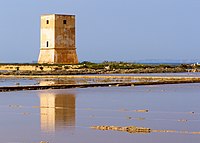 Torre Nubia (Paceco)
Torre Nubia (Paceco)
-
 Torre Manfria (Gela)
Torre Manfria (Gela)
-
 Torre Cabrera (Marina di Ragusa)
Torre Cabrera (Marina di Ragusa)
-
Torre Cabrera (Pozzallo) (Pozzallo)
-
Vignazza Tower (Giardini Naxos)
Historical villages
Sicily has many small and picturesque villages; 24 of them have been selected by I Borghi più belli d'Italia (English: The most beautiful Villages of Italy), a non-profit private association of small Italian towns of strong historical and artistic interest, that was founded on the initiative of the Tourism Council of the National Association of Italian Municipalities.
Culture
See also: List of museums in SicilyTo have seen Italy without having seen Sicily is to not have seen Italy at all, for Sicily is the clue to everything.
— Goethe

Sicily has long been associated with the arts; many poets, writers, philosophers, intellectuals, architects and painters have roots on the island. Among the earliest illuminaries there are Gorgias and Empedocles, two highly noted Sicilian-Greek philosophers, while the Syracusan-Greek Epicharmus is held to be the inventor of comedy. One of the most famous intellectuals in Greek antiquity was Archimedes, a Syracuse native who is recognized as one of the greatest mathematicians of all time.
Art and architecture
Baglio are traditional living structures in Western Sicily.
Ceramics
Terracotta ceramics from the island are well known, the art of ceramics on Sicily goes back to the original ancient peoples named the Sicanians, it was then perfected during the period of Greek colonisation and is still prominent and distinct to this day. Nowadays, Caltagirone is one of the most important centres in Sicily for the artistic production of ceramics and terra-cotta sculptures. Famous painters include Renaissance artist Antonello da Messina, Pietro Novelli, Bruno Caruso, Renato Guttuso and Greek born Giorgio de Chirico who is commonly dubbed the "father of Surrealist art" and founder of the metaphysical art movement. The most noted architects are Filippo Juvarra (one of the most important figures of the Italian Baroque) and Ernesto Basile.
Sicilian Baroque
Main article: Sicilian BaroqueThe Sicilian Baroque has a unique architectural identity. Noto, Caltagirone, Catania, Ragusa, Modica, Scicli and particularly Acireale contain some of Italy's best examples of Baroque architecture, carved in the local red sandstone. Noto provides one of the best examples of the Baroque architecture brought to Sicily. The Baroque style in Sicily was largely confined to buildings erected by the church, and palazzi built as private residences for the Sicilian aristocracy. The earliest examples of this style in Sicily lacked individuality and were typically heavy-handed pastiches of buildings seen by Sicilian visitors to Rome, Florence, and Naples. However, even at this early stage, provincial architects had begun to incorporate certain vernacular features of Sicily's older architecture. By the middle of the 18th century, when Sicily's Baroque architecture was noticeably different from that of the mainland, it has a unique freedom of design that is difficult to characterize in words.
-
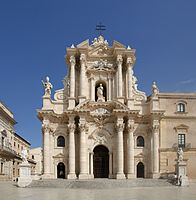 Syracuse, Cathedral
Syracuse, Cathedral
-
 Catania, Basilica Collegiata
Catania, Basilica Collegiata
-
 Noto, Palazzo Nicolaci
Noto, Palazzo Nicolaci
-
 Modica, church of San Pietro
Modica, church of San Pietro
Music and film
See also: Music of Sicily
Palermo hosts the Teatro Massimo which is the largest opera house in Italy and the third largest in all of Europe. In Catania there is another important opera house, the Teatro Massimo Bellini with 1,200 seats, which is considered one of the best European opera houses for its acoustics. Sicily's composers vary from Vincenzo Bellini, Sigismondo d'India, Giovanni Pacini and Alessandro Scarlatti, to contemporary composers such as Salvatore Sciarrino and Silvio Amato.
Many films of Italian cinema have been filmed in Sicily, amongst the most noted of which are: Visconti's "La Terra Trema" and "Il Gattopardo", Pietro Germi's "Divorzio all'Italiana" and "Sedotta e Abbandonata", Tornatore's "Cinema Paradiso".
The annual Taormina Film Fest takes places in Taormina.
Literature
See also: Italian literature and Sicilian School
The golden age of Sicilian poetry began in the early 13th century with the Sicilian School of Giacomo da Lentini, which was highly influential on Italian literature. Some of the most noted figures among writers and poets are Luigi Pirandello (Nobel laureate, 1934), Salvatore Quasimodo (Nobel laureate, 1959), Giovanni Verga (the father of the Italian Verismo), Domenico Tempio, Giovanni Meli, Luigi Capuana, Mario Rapisardi, Federico de Roberto, Leonardo Sciascia, Vitaliano Brancati, Giuseppe Tomasi di Lampedusa, Elio Vittorini, Vincenzo Consolo and Andrea Camilleri (noted for his novels and short stories with the fictional character Inspector Salvo Montalbano as protagonist). On the political side notable philosophers include Gaetano Mosca and Giovanni Gentile who wrote The Doctrine of Fascism.
Languages
Main articles: Sicilian language, Gallo-Italic of Sicily, and Arbëresh languageToday, in Sicily, most people are bilingual and speak both Italian and Sicilian, a Romance language distinct from Italian. Some Sicilian words are loanwords from Greek, Catalan, Norman, French, Arabic, Spanish and other languages. Varieties related to Sicilian are also spoken in Calabria and Salento. Nowadays, the use of Sicilian is limited to informal contexts (mostly in family) and in a majority of cases it is replaced by the so-called regional Italian of Sicily, a variety of Italian that is influenced by Sicilian. Sicilian had a significant influence on the Maltese language.
Sicilian was an early influence in the development of the first Italian standard, although its use remained confined to an intellectual elite. This was a literary language in Sicily created under the auspices of Frederick II and his court of notaries, or Magna Curia, which, headed by Giacomo da Lentini, also gave birth to the Sicilian School, widely inspired by troubadour literature. Its linguistic and poetic heritage was later assimilated into the literary Florentine dialect use by Dante Alighieri, the father of modern Italian. Dante, in his De vulgari eloquentia, claims that "In effect, this vernacular seems to deserve higher praise than the others since all the poetry written by Italians can be called Sicilian". It is in this language that appeared the first sonnet, whose invention is attributed to Giacomo da Lentini himself.
Other languages are spoken in Sicily. Within the province of Palermo, four towns are home to speakers of Arbërësh varieties. Arbërësh is the name given to varieties of Albanian spoken in Italy. In the eastern part of the island, there are Gallo-Italic varieties known as Gallo-Italic of Sicily, which are related to the other Gallo-Italic languages spoken in most of northern Italy and in other isolated pockets of southern Italy.
Science
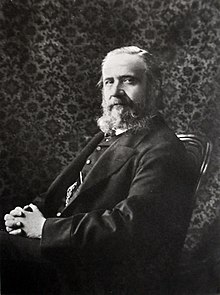
Catania has one of the four laboratories of the Istituto Nazionale di Fisica Nucleare (National Institute for Nuclear Physics) in which there is a cyclotron that uses protons both for nuclear physics experiments and for particle therapy to treat cancer (proton therapy). Noto has one of the largest radio telescopes in Italy that performs geodetic and astronomical observations. There are observatories in Palermo and Catania, managed by the Istituto Nazionale di Astrofisica (National Institute for Astrophysics). In the Observatory of Palermo the astronomer Giuseppe Piazzi discovered the first and the largest asteroid to be identified Ceres (today considered a dwarf planet) on 1 January 1801; Catania has two observatories, one of which is situated on Mount Etna at 1,800 metres (5,900 feet).
Syracuse is also an experimental centre for solar technologies through the creation of the project Archimede solar power plant that is the first concentrated solar power plant to use molten salt for heat transfer and storage which is integrated with a combined-cycle gas facility. All the plant is owned and operated by Enel. The touristic town of Erice is also an important science place thanks to the Ettore Majorana Foundation and Centre for Scientific Culture which embraces 123 schools from all over the world, covering all branches of science, offering courses, seminars, workshops, and annual meetings. It was founded by the physicist Antonino Zichichi in honour of another scientist of the island, Ettore Majorana known for the Majorana equation and Majorana fermions. Sicily's famous scientists also include Stanislao Cannizzaro (chemist), Giovanni Battista Hodierna and Niccolò Cacciatore (astronomers).

Education
Sicily has four universities:
- The University of Catania dates back to 1434 and it is the oldest university in Sicily. It currently hosts 12 faculties and over 62,000 students and it offers undergraduate and postgraduate programs. Catania hosts also the Scuola Superiore, an academic institution linked to the University of Catania, aiming for excellence in education.
- The University of Palermo is the island's second-oldest university. It was officially founded in 1806, although historical records indicate that medicine and law have been taught there since the late 15th century. The Orto botanico di Palermo (Palermo botanical gardens) is home to the university's Department of Botany and is also open to visitors.
- The University of Messina, founded in 1548 by Ignatius of Loyola. It is organized in 11 Faculties.
- The Kore University of Enna founded in 1995, is the latest Sicilian university and the first university founded in Sicily after the Italian Unification.
Cuisine
Main articles: Sicilian cuisine and Sicilian pizza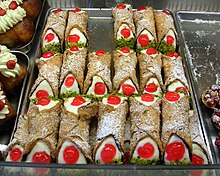

The island has a long history of producing a variety of noted cuisines and wines, to the extent that Sicily is sometimes nicknamed God's Kitchen because of this. Every part of Sicily has its speciality (e.g. Cassata is typical of Palermo although available everywhere in Sicily, as is Granita). The ingredients are typically rich in taste while remaining affordable to the general public. The savoury dishes of Sicily are viewed to be healthy, using fresh vegetables and fruits, such as tomatoes, artichokes, olives (including olive oil), citrus, apricots, aubergines, onions, beans, raisins commonly coupled with seafood, freshly caught from the surrounding coastlines, including tuna, sea bream, sea bass, cuttlefish, swordfish, sardines, and others.
The most well-known part of Sicilian cuisine is the rich sweet dishes including ice creams and pastries. Cannoli (singular: cannolo), a tube-shaped shell of fried pastry dough filled with a sweet filling usually containing ricotta, is strongly associated with Sicily worldwide. Biancomangiare, biscotti ennesi (cookies native to Enna), braccilatte (a Sicilian version of doughnuts), buccellato, ciarduna, pignoli, Biscotti Regina, giurgiulena, frutta martorana, cassata, pignolata, granita, cuccidati (a variety of fig cookie; also known as buccellati) and cuccìa are some notable sweet dishes.
Like the cuisine of the rest of southern Italy, pasta plays an important part in Sicilian cuisine, as does rice; for example with arancini. As well as using some other cheeses, Sicily has spawned some of its own, using both cow's and sheep's milk, such as pecorino and caciocavallo. Spices used include saffron, nutmeg, clove, pepper, and cinnamon, which were introduced by the Arabs. Parsley is used abundantly in many dishes. Although Sicilian cuisine is commonly associated with sea food, meat dishes, including goose, lamb, goat, rabbit, and turkey, are also found in Sicily. It was the Normans and Swabians who first introduced a fondness for meat dishes to the island. Some varieties of wine are produced from vines that are relatively unique to the island, such as the Nero d'Avola made near the baroque town of Noto.
Sports

The most popular sport in Sicily is football, which came to the fore in the late 19th century under the influence of the English. Some of the oldest football clubs in Italy are from Sicily: the three most successful are Palermo, Catania, and Messina, which have played 29, 17 and 5 seasons in the Serie A respectively. No club from Sicily has ever won Serie A, but football is still deeply embedded in local culture and all over Sicily most towns have a representative team.
Palermo and Catania have a heated rivalry and compete in the Sicilian derby together. Palermo is the only team in Sicily to have played on the European stage, in the UEFA Cup. In the island, the most noted footballer is Salvatore Schillaci, who won the Golden Boot at the 1990 FIFA World Cup with Italy. Other noted players include Giuseppe Furino, Pietro Anastasi, Francesco Coco, Christian Riganò, and Roberto Galia. There have also been some noted managers from the island, such as Carmelo Di Bella and Franco Scoglio.
Although football is the most popular sport in Sicily, the island also has participants in other fields. Amatori Catania have competed in the top Italian national rugby union league called National Championship of Excellence. They have even participated at the European level in the European Challenge Cup. Competing in the basketball variation of Serie A is Orlandina Basket from Capo d'Orlando in the province of Messina, where the sport has a reasonable following. Various other sports that are played to some extent include volleyball, handball, and water polo. Previously, in motorsport, Sicily held the prominent Targa Florio sports car race that took place in the Madonie Mountains, with the start-finish line in Cerda. The event was started in 1906 by Sicilian industrialist and automobile enthusiast Vincenzo Florio, and ran until it was canceled due to safety concerns in 1977.
From 28 September to 9 October 2005 Trapani was the location of Acts 8 and 9 of the Louis Vuitton Cup. This sailing race featured, among other entrants, all boats that took part in the 2007 America's Cup.
Popular culture
Each town and city has its own patron saint, and the feast days are marked by colourful processions through the streets with marching bands and displays of fireworks.
Sicilian religious festivals also include the presepe vivente (living nativity scene), which takes place at Christmas time. Deftly combining religion and folklore, it is a constructed mock 19th-century Sicilian village, complete with a nativity scene, and has people of all ages dressed in the costumes of the period, some impersonating the Holy Family, and others working as artisans of their particular assigned trade. It is normally concluded on Epiphany, often highlighted by the arrival of the magi on horseback.
Oral tradition plays a large role in Sicilian folklore. Many stories passed down from generation to generation involve a character named "Giufà". Anecdotes from this character's life preserve Sicilian culture as well as convey moral messages.
Sicilians also enjoy outdoor festivals, held in the local square or piazza where live music and dancing are performed on stage, and food fairs or sagre are set up in booths lining the square. These offer various local specialties, as well as typical Sicilian food. Normally these events are concluded with fireworks. A noted sagra is the Sagra del Carciofo or Artichoke Festival, which is held annually in Ramacca in April. The most important traditional event in Sicily is the carnival. Famous carnivals are in Acireale, Misterbianco, Regalbuto, Paternò, Sciacca, Termini Imerese.
The Opera dei Pupi (Opera of the Puppets; Sicilian: Òpira dî pupi) is a marionette theatrical representation of Frankish romantic poems such as the Song of Roland or Orlando furioso that is one of the characteristic cultural traditions of Sicily. The sides of donkey carts are decorated with intricate, painted scenes; these same tales are enacted in traditional puppet theatres featuring hand-made marionettes of wood. The opera of the puppets and the Sicilian tradition of cantastorî (singers of tales) are rooted in the Provençal troubadour tradition in Sicily during the reign of Frederick II, Holy Roman Emperor, in the first half of the 13th century. A great place to see this marionette art is the puppet theatres of Palermo. The Sicilian marionette theatre Opera dei Pupi was proclaimed in 2001 and inscribed in 2008 in the UNESCO Intangible Cultural Heritage Lists.
Today, there are only a few troupes that maintain the tradition. They often perform for tourists. However, there are no longer the great historical families of marionettists, such as the Greco of Palermo; the Canino of Partinico and Alcamo; Crimi, Trombetta and Napoli of Catania, Pennisi and Macri of Acireale, Profeta of Licata, Gargano and Grasso of Agrigento. One can, however, admire the richest collection of marionettes at the Museo Internazionale delle Marionette Antonio Pasqualino and at the Museo Etnografico Siciliano Giuseppe Pitrè in Palermo. Other elaborate marionettes are on display at the Museo Civico Vagliasindi in Randazzo.
-
Sicilian arrotino at a living nativity scene wearing traditional Sicilian clothing
-
 The "Misteri", a religious festival in Trapani
The "Misteri", a religious festival in Trapani
-
A carnival float in Acireale
-
The marionettes used in the Opera dei Pupi
Traditional items

The Sicilian cart is an ornate, colourful style of a horse- or donkey-drawn cart native to Sicily. Sicilian woodcarver George Petralia states that horses were mostly used in the city and flat plains, while donkeys or mules were more often used in rough terrain for hauling heavy loads. The cart has two wheels and is primarily handmade out of wood with iron components.
The Sicilian coppola is a traditional kind of flat cap typically worn by men in Sicily. First used by English nobles during the late 18th century, the tascu began being used in Sicily in the early 20th century as a driving cap, usually worn by car drivers. The coppola is usually made in tweed. Today it is widely regarded as a definitive symbol of Sicilian heritage.
Flag and emblem
Main articles: Triskelion § Sicily, and Flag of SicilyThe Flag of Sicily, regarded as a regional icon, was first adopted in 1282, after the Sicilian Vespers of Palermo. It is characterised by the presence of the triskeles in the middle, depicting the head of Medusa and three wheat ears representing the extreme fertility of the land of Sicily. In early mythology, when Medusa was slain and beheaded by Perseus, the Medusa head was placed in the centre of Athena's shield.
Palermo and Corleone were the first two cities to found a confederation against the Angevin rule. The triskeles symbol came to be on the Sicilian flag in 1943 during World War II when Andrea Finocchiaro Aprile led an independence movement, in collaboration with the allies. Their plan was to help Sicily become independent and form a free republic. The colours, likewise introduced in the 1940s, respectively represent the cities of Palermo and Corleone. The separatist behind the movement used a yellow and red flag with the Trinacria in the centre of it. When World War II ended, Sicily was recognized as an autonomous region in the Italian Republic.
The flag became the official public flag of the Regione Siciliana in January 2000, after the passing of an apposite regional law which advocates its use on public buildings, schools and city halls along with the national Italian flag and the European one.
Familiar as an ancient symbol of the region, the Triskelion is also featured on Greek coins of Syracuse, such as coins of Agathocles (317–289 BC).The symbol dates back to when Sicily was part of Magna Graecia, the colonial extension of Greece beyond the Aegean. The triskelion was revived, as a neoclassic – and non-Bourbon – emblem for the new Napoleonic Kingdom of the Two Sicilies, by Joachim Murat in 1808. In the case of Sicily, the triskelion symbol is said to represent the three capes (headlands or promontories of the island of Sicily, namely: Pelorus (Peloro, Tip of Faro, Messina: North-East); Pachynus (Passero, Syracuse: South); and Lilybæum (Lilibeo, Cape Boeo, Marsala: West), which form three points of a triangle.
-
 Triskelion painted on Ancient Greek vase, Agrigento
Triskelion painted on Ancient Greek vase, Agrigento
-
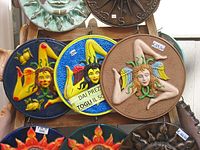 The Triskelion symbol of Sicily
The Triskelion symbol of Sicily
See also
References
- ^ "Statistiche demografiche ISTAT". Demo.istat.it. Retrieved 12 August 2024.
- "Region Sicilia".
- "Population on 1 January by age, sex and NUTS 2 region". www.ec.europa.eu.
- "Sub-national HDI – Area Database – Global Data Lab". hdi.globaldatalab.org. Retrieved 5 March 2023.
- Pasquale Hamel – L' invenzione del regno. Dalla conquista normanna alla fondazione del Regnum Siciliae (1061–1154)
- "Sicilia nell'Enciclopedia Treccani". www.treccani.it (in Italian). Retrieved 22 December 2020.
- Britannica – Travel & Geography – Sicily Italian Sicilia – retrieved 11 May 2010.
- "Sicily". Encyclopædia Britannica.
- Raworth, Philip (2007). "The Autonomous Region of Sicily: Introductory Note". Oxford University Press.
- ^ Porter, Darwin; Prince, Danforth (2009). Frommer's Sicily. Frommer's. p. 268. ISBN 978-0-470-39899-9.
- Barberi, F.; Civetta, L.; Gasparini, P.; Innocenti, F.; Scandone, R.; Villari, L. (1 May 1974). "Evolution of a section of the Africa-Europe plate boundary: Paleomagnetic and volcanological evidence from Sicily". Earth and Planetary Science Letters. 22 (2): 123–132. Bibcode:1974E&PSL..22..123B. doi:10.1016/0012-821X(74)90072-7. ISSN 0012-821X.
- "Il cratere Voragine dell'Etna cresce, bordo supera 3.400 metri - Notizie - Ansa.it". Agenzia ANSA (in Italian). 18 September 2024. Retrieved 24 September 2024.
- Thomaidis, Konstantinos; Troll, Valentin R.; Deegan, Frances M.; Freda, Carmela; Corsaro, Rosa A.; Behncke, Boris; Rafailidis, Savvas (2021). "A message from the 'underground forge of the gods': history and current eruptions at Mt Etna". Geology Today. 37 (4): 141–149. Bibcode:2021GeolT..37..141T. doi:10.1111/gto.12362. ISSN 1365-2451. S2CID 238802288.
- PeakVisor. "Monte Soro". PeakVisor. Retrieved 4 April 2024.
- "Monte San Calògero : Climbing, Hiking & Mountaineering : SummitPost". www.summitpost.org. Retrieved 4 April 2024.
- "Agenzia Regionale per i Rifiuti e le Acque". Osservatorio delle Acque. Archived from the original on 22 July 2011. Retrieved 14 October 2010.
- "WMO is monitoring potential new temperature records". public.wmo.int. 17 July 2023. Retrieved 17 July 2023.
- Trabia, Carlo (2002). "A Sicilian Desert?". Best of Sicily Magazine.
- Lillie, Barry (5 April 2014). "The Chestnut Tree of One Hundred Horses: Sicily's Most Famous Tree". Italy Magazine.
- da Silveira Bueno, R.; Giardina, G.; La Mantia, T. (1 January 2020). "Fallow Deer in Sicily: recent history, consistence and ecological role". University of Palermo. hdl:10447/514729.
- Sicilia, flora e fauna-Specie vegetali e animali in Sicilia. Insicilia.org. Retrieved on 18 December 2012.
- Biosa, Daniela; Scandura, Massimo; Tagliavini, James; Luccarini, Siriano; Mattioli, Luca; Apollonio, Marco (24 June 2015). "Patterns of genetic admixture between roe deer of different origin in central Italy". Journal of Mammalogy. 96 (4): 827–838. doi:10.1093/jmammal/gyv098.
- Palombo, Maria Rita; Antonioli, Fabrizio; Di Patti, Carolina; Valeria, Lo Presti; Scarborough, Matthew E. (3 October 2021). "Was the dwarfed Palaeoloxodon from Favignana Island the last endemic Pleistocene elephant from the western Mediterranean islands?". Historical Biology. 33 (10): 2116–2134. Bibcode:2021HBio...33.2116P. doi:10.1080/08912963.2020.1772251. ISSN 0891-2963. S2CID 225710152.
- "RISERVA DELLO ZINGARO". Visit Sicily. 7 October 2015.
- Cassell's Latin Dictionary, Marchant, J.R.V, & Charles, Joseph F., (Eds.), Revised Edition, 1928
- "Sicilian Culture: The Folklore, Legends & Traditions: Trinacria." Sicilian Culture: The Folklore, Legends & Traditions: Trinacria. N.p., n.d. Web. 9 November 2014. "Sicily." Sicily. N.p., n.d. Web. 10 November 2014.
- Di Maida, Gianpiero (3 July 2022). "The earliest human occupation of Sicily: A review". The Journal of Island and Coastal Archaeology. 17 (3): 402–419. doi:10.1080/15564894.2020.1803460. ISSN 1556-4894. S2CID 250926924.
- Piccolo, Salvatore; Darvill, Timothy (2013). Ancient Stones, The Prehistoric Dolmens of Sicily. Thornham/Norfolk: Brazen Head Publishing. ISBN 9780956510624. Retrieved 17 October 2013.
- Ibidem, p. 31.
- "The Sicani and agriculture". Antropocene. 5 June 2023.
- "Aapologetico de la literatura española contra los opiniones". Ensayo historico. 7 October 2007.
- Fine, John Van Antwerp (1983). The Ancient Greeks: A Critical History. Harvard University Press. p. 72. ISBN 9780674033146.
most scholars now believe that the sicans and Sicels, as well as the.
- ^ "Sicilian Peoples: The Sicanians". Best of Sicily. 7 October 2007.
- "Sicani". Britannica.com. 7 October 2007.
- ^ Herbermann, Charles, ed. (1913). "Sicily" . Catholic Encyclopedia. New York: Robert Appleton Company.
- E. Zuppardo-S.Piccolo, Terra Mater: sulle sponde del Gela greco, Betania Ed., Caltanissetta 2005
- ^ "History of Sicily". knowital.com. 7 October 2007. Archived from the original on 1 August 2003.
- "Valley of the Temples". Italiansrus.com. 7 October 2007.
- "Siege of Syracuse". Livius.org. 7 October 2007. Archived from the original on 7 November 2016. Retrieved 26 March 2020.
- Miles, Richard (2010). Carthage Must Be Destroyed: The Rise and Fall of an Ancient Civilization. New York: Viking. ISBN 978-0-143-12129-9.
- "Sicily". Hutchinson Encyclopedia. 7 October 2007. Archived from the original on 2 December 2008.
- Miles, Richard (2010). Carthage Must Be Destroyed. New York: Viking.
- Norwich, John Julius (21 July 2015). Sicily: An Island at the Crossroads of History. Random House. ISBN 978-0812995190. OCLC 904715530. Retrieved 1 July 2023 – via Google Books.
- Stockton, David L. (1971). Cicero: A Political Biography. Oxford University Press. ISBN 978-0-19-872033-1. OCLC 1301799183 – via Google Books.
- ^ "Early & Medieval History". BestofSicily.com. 7 October 2007.
- ^ Privitera, John (2002). Sicily: An Illustrated History. Hippocrene Books. ISBN 978-0-7818-0909-2.
- J.B. Bury, History of the Later Roman Empire, 1958 edition, p. 254
- Bury, p. 327.
- Bury, pp. 410, 425.
- "Theodoric". Encyclopædia Britannica. 7 October 2007.
- Frassetto, Michael (2003), Encyclopedia of Barbarian Europe: Society in Transformation. Santa Barbara, CA, p. 335: ABC-CLIO. ISBN 978-1-57607-263-9.
- Hearder, Harry (25 January 1991). Italy: A Short History. Cambridge University Press. ISBN 978-0-521-33719-9.
- ^ "Gothic War: Byzantine Count Belisarius Retakes Rome". Historynet.com. 7 October 2007. Archived from the original on 2 November 2007.
- Kazhdan, Alexander, ed. (1991). Oxford Dictionary of Byzantium. Oxford University Press. p. 1892. ISBN 978-0-19-504652-6.
- Davis-Secord, Sarah (2017). "Sicily in the Early Medieval Mediterranean". Where Three Worlds Met: Sicily in the Early Medieval Mediterranean. Ithaca: Cornell University Press. p. 79. ISBN 9781501704642. JSTOR 10.7591/j.ctt1qv5qfp.
- ^ "Syracuse, Sicily". TravelMapofSicily.com. 7 October 2007. Archived from the original on 6 June 2008. Retrieved 4 December 2007.
- "Sicilian Peoples: The Byzantines". BestofSicily.com. 7 October 2007.
- Treadgold. History of the Byzantine State, pp. 354–355.
- ^ "Brief history of Sicily" (PDF). Archaeology.Stanford.edu. 7 October 2007. Archived from the original (PDF) on 9 June 2007.
- "Where the Maltese language comes from". The Economist. ISSN 0013-0613. Retrieved 26 October 2022.
- Alex Metcalfe (11 March 2014). Muslims of Medieval Italy. Edinburgh University Press. pp. 66–. ISBN 978-0-7486-8843-2.
- Raphael Patai, The Jewish Mind, Scribners, 1977, p. 155–6
- "Jewish Catacombs of Venosa". Visit Jewish Italy. Retrieved 25 April 2024.
- ^ "Italy during the Crusades – Sicily under the Normans" – History of the Crusades – Boise State University – Retrieved 15 July 2011.
- ^ "Chronological – Historical Table of Sicily". In Italy Magazine. 7 October 2007. Archived from the original on 27 July 2016. Retrieved 12 December 2007.
- Johns, Jeremy (2002). Arabic Administration in Norman Sicily: The Royal Diwan. Cambridge studies in Islamic civilization. Cambridge, England: Cambridge University Press. pp. 249–250. ISBN 978-0-521-81692-2.
- Takayama, Hiroshi (1993). The Administration of the Norman Kingdom of Sicily. Leiden, the Netherlands: E.J. Brill. p. 123. ISBN 978-90-04-09920-3.
- "Classical and Medieval Malta (60–1530)". AboutMalta.com. 7 October 2007.
- Norwich, John Julius (1992). The Normans in Sicily: The Normans in the South 1016–1130 and the Kingdom in the Sun 1130–1194. Penguin Global. ISBN 978-0-14-015212-8.
- ^ "Norman Sicily of the 12th Century" – Inter-American Institute for Advanced Studies in Cultural History – Retrieved 15 July 2011.
- ^ Loud, G. A. (2007). The Latin Church in Norman Italy. Cambridge University Press. p. 494. ISBN 978-0-521-25551-6.
ISBN 0-521-25551-1" "At the end of the twelfth-century ... While in Apulia Greeks were in a majority – and indeed present in any numbers at all – only in the Salento peninsula in the extreme south, at the time of the conquest they had an overwhelming preponderance in Lucaina and central and southern Calabria, as well as comprising anything up to a third of the population of Sicily, concentrated especially in the north-east of the island, the Val Demone.
- "Sicilian Peoples: The Normans". BestofSicily.com. 7 October 2007.
- ^ Dieli, Art (8 July 2015). "Sicilian History: An Abbreviated Chronology". Dieli.net.
- Taylor, Julie (19 August 2003). Muslims in Medieval Italy: The Colony at Lucera. Lexington Books. ISBN 9780739157978 – via Google Books.
- Snell, Melissa (30 July 2019). "The Arrival and Spread of the Black Plague in Europe". ThoughtCo. Retrieved 24 January 2024.
- "Italy's earthquake history". BBC News. 31 October 2002.
- Rees Davies, British Slaves on the Barbary Coast, BBC, 1 July 2003
- "Christian Slaves, Muslim Masters: White Slavery in the Mediterranean, the Barbary Coast and Italy, 1500–1800". Robert Davis (2004) ISBN 1-4039-4551-9
- "The Treaties of Utrecht (1713)". Heraldica.org. 7 October 2007.
- "Charles of Bourbon – the restorer of the Kingdom of Naples". RealCasaDiBorbone.it. 7 October 2007. Archived from the original on 4 August 2003.
- "Campo Tenese". Clash-of-Steel.co.uk. 7 October 2007.
- Regno Delle Due Sicilie nell'Enciclopedia Treccani. Treccani.it. Retrieved on 18 December 2012.
- ^ "Italians around the World: Teaching Italian Migration from a Transnational Perspective". OAH.org. 7 October 2007. Archived from the original on 27 November 2010.
- Sicily (island, Italy) – Britannica Online Encyclopaedia. Britannica.com. Retrieved on 18 December 2012.
- "Sicily". Capitol Hill. 7 October 2007. Archived from the original on 18 October 2007.
- "fascio siciliano". Encyclopædia Britannica. 7 October 2007.
- Arma dei Carabinieri – Home – L'Arma – Ieri – Storia – Vista da – Fascicolo 22. Carabinieri.it. Retrieved on 18 December 2012.
- "Messina earthquake and tsunami". Britannica Online Encyclopedia.
- "Modern Sicilian History & Society". BestofSicily.com.
- "Sicily autonomy". Grifasi-Sicilia.com. 7 October 2007.
- "Le spinte e i ritorni": gli anni delle riforme per lo sviluppo in Sicilia (1947–1967)". Storicamente.org (in Italian). Archived from the original on 24 May 2013. Retrieved 18 December 2012.
- "Due eroi italiani – Materiali didattici di Scuola d'Italiano Roma a cura di Roberto Tartaglione". Scudit.net (in Italian). 11 April 2004. Retrieved 18 December 2012.
- "Italy – Land Reforms". Encyclopædia Britannica. 7 October 2007.
- "Sicilia". Istat.it (in Italian). Archived from the original on 15 November 2012. Retrieved 18 December 2012.
- Pantaleone, Wladimir (4 December 2018). "Italy police arrest alleged new mafia boss in Sicily". Global News. Retrieved 22 June 2021.
- Messia, Hada; Kent, Lauren (17 July 2019). "19 mafia suspects arrested in joint transatlantic raids". CNN. Retrieved 22 June 2021.
- Giuffrida, Angela (17 July 2019). "FBI and Italian police arrest 19 people in Sicily and US in mafia investigation". The Guardian. Retrieved 22 June 2021.
- "Statistiche demografiche ISTAT". Demo.istat.it. Archived from the original on 30 June 2016. Retrieved 29 May 2016.
- "Bilancio demografico anno 2017 Regione: Sicilia". demo.istat.it. 2017. Archived from the original on 19 October 2019. Retrieved 14 September 2017.
- "Bilancio demografico popolazione straniera".
- "Legge 482". camera.it. Archived from the original on 12 May 2015. Retrieved 28 February 2013.
- "Corriere della Sera – Italia, quasi l'88% si proclama cattolico". corriere.it.
- Pitroso, Giulio (2022). "Una prospettiva regionalista su 'Italian Diaspora' e 'Anti-Italianism' in Australia e negli Stati Uniti; A regionalist perspective on 'Italian Diaspora' and 'Anti-Italianism' in Australia and in the United States". Nazioni e Regioni (19–20): 119–138. doi:10.15162/2282-5681/1683. ISSN 2282-5681.
- "La questione meridionale 3/ Il saccheggio del Banco delle due Sicilie". 9 December 2017.
- "Disastro Sicilia: In fuga i suoi figli". 31 October 2017.
- "Emigrazione, fuga dalla Sicilia: Ogni anno cancellato un paese di ventimila abitanti". 29 January 2016.
- "Sicilia / Sicily (Italy): Provinces, Major Cities & Communes – Population Statistics, Maps, Charts, Weather and Web Information". www.citypopulation.de. Retrieved 28 April 2019.
- Nebel, A; Filon, D; Brinkmann, B; Majumder, P; Faerman, M; Oppenheim, A (2001). "The Y Chromosome Pool of Jews as Part of the Genetic Landscape of the Middle East". The American Journal of Human Genetics. 69 (5): 1095–112. doi:10.1086/324070. PMC 1274378. PMID 11573163.
- "Catholic Church in Italy [Catholic-Hierarchy]". www.catholic-hierarchy.org. Retrieved 21 August 2023.
- Peppe Cuva (12 May 2012). Sicilia, l'ex roccaforte del centro-destra. Latestatanews.it. Retrieved on 18 December 2012.
- Population May 2011, data from Demo Istat Archived 1 July 2011 at the Wayback Machine. Demo.istat.it. Retrieved on 18 December 2012.
- Economia della Sicilia: agricoltura. Sicilyweb.com. Retrieved on 18 December 2012.
- L'industria in Sicilia così antica e moderna. Il Sole 24 ORE (23 February 2011). Retrieved on 18 December 2012.
- Sicilia: Congiuntura economica.Treccani.it. Retrieved on 19 December 2012.
- Investire nel turismo di qualità e negli eventi in Sicilia. Strumentires.com. Retrieved on 18 December 2012.
- (in Italian) Conti economici regionali. Istat.it. Retrieved on 18 December 2012.
- Sicilia: L'Economia Archived 8 March 2021 at the Wayback Machine. SicilyOnTour.com. Retrieved on 18 December 2012.
- Pistacchio di Bronte D.O.P. Pistacchiodibronte.it. Retrieved on 18 December 2012.
- Fico d'India dell'Etna dop. Tavolaegusto.it. Retrieved on 18 December 2012.
- ^ economia-sicilia. insicilia.org. Retrieved on 19 December 2012.
- miele ibleo. siciliaonline.it. Retrieved on 19 December 2012.
- Produzione vino in Italia nel 2010 – fonte: ISTAT | I numeri del vino. Inumeridelvino.it (30 May 2011). Retrieved on 18 December 2012.
- "Sicily: An Island You Can't Refuse". bottlenotes.com. 18 August 2009. Archived from the original on 22 August 2009. Retrieved 30 November 2009.
- Vini siciliani Archived 19 February 2022 at the Wayback Machine. sicilyontour.com. Retrieved on 19 December 2012.
- ^ (in Italian) Economia Regione Siciliana. Esploriamo.com. Retrieved on 18 December 2012.
- Oggi la chiamano Etna Valley: i progetti, le aziende, il lavoro nel territorio di Catania Archived 27 May 2010 at the Wayback Machine. Etnavalley.com (27 November 2012). Retrieved on 18 December 2012.
- Economia della Sicilia. Sicilyweb.com. Retrieved on 18 December 2012.
- Enna. Il nuovo volto dell'Area di Sviluppo Industriale di Dittaino. Vivienna.it (22 March 1999). Retrieved on 18 December 2012.
- Sicilia: L'Economia Archived 16 May 2021 at the Wayback Machine. SicilyOnTour.com. Retrieved on 18 December 2012.
- La lavorazione del Sale a Trapani, Area Sale Archived 15 December 2012 at the Wayback Machine. Sale-salute-benessere.it. Retrieved on 18 December 2012.
- "Dati Istat – Tavole regionali". Istat.it. Archived from the original on 9 March 2008. Retrieved 23 April 2010.
- Sicilia nel 2008 PIL a '0.7% Archived 22 February 2012 at the Wayback Machine livesicilia.it
- "Unemployment rate by NUTS 2 regions". ec.europa.eu. Eurostat. Retrieved 19 September 2019.
- "Tasso di disoccupazione - livello regionale". dati.istat.it (in Italian). Retrieved 19 September 2019.
- "A 19 autostrada Palermo – Catania". SiciliaEMoto.it. 2 January 2008. Archived from the original on 23 January 2019. Retrieved 2 January 2008.
- "Autostrada A20: Messina – Palermo". Sicilia.Indettaglio.it. 24 October 2007.
- "A 29 autostrada Palermo – Trapani – Mazara del Vallo". SiciliaEMoto.it. 2 January 2008. Archived from the original on 23 January 2019. Retrieved 2 January 2008.
- "Autostrada: A18 Messina – Catania". Sicilia.Indettaglio.it. 24 October 2007.
- "Sicily Travel and Transport". ItalyHeaven.co.uk. 2 January 2008.
- "Traghetti Sicily 2008". Traghetti Guida. 2 January 2008. Archived from the original on 14 November 2007.
- "High speed car/passenger ferry service". VirtuFerries.com. 2 January 2008. Archived from the original on 12 August 2008.
- "Italy revives Sicily bridge plan". BBC News. Retrieved 8 March 2009.
- Hooper, John (2 January 2008). "Italian MPs kill plan to bridge Sicily and mainland". Guardian.co.uk. London. Retrieved 30 March 2010.
- Kahn, Gabriel (10 April 2008). "No Italian Job Takes Longer Than This Bridge". Wall Street Journal.
- The Godfather. Sicilian Shooting* Locations. thegodfathertrilogy.com
- "Archaeological Area of Agrigento – UNESCO World Heritage Centre". Whc.unesco.org. 7 December 1997. Retrieved 6 May 2009.
- R. J. A. Wilson: Piazza Armerina. In: Akiyama, Terakazu (Ed.): The dictionary of Art. Vol. 24: Pandolfini to Pitti. Oxford 1998, ISBN 0-19-517068-7.
- "Isole Eolie (Aeolian Islands) – UNESCO World Heritage Centre". Whc.unesco.org. 30 November 2000. Retrieved 6 May 2009.
- Noto (Italy) – No 1024rev, ICOMOS, January 2002, Advisory Body Evaluation, Unesco
- "Mount Etna Becomes a World Heritage Site". Italy Magazine. 4 May 2013.
- Centre, UNESCO World Heritage. "Arab-Norman Palermo and the Cathedral Churches of Cefalú and Monreale".
- "Taormina and Isola Bella". World Heritage Site. Archived from the original on 22 May 2019.
- "Mothia and Libeo Island: The Phoenician-Punic Civilization in Italy". World Heritage Site. Archived from the original on 22 May 2019.
- All Tentative Sites Archived 14 January 2013 at the Wayback Machine. World Heritage Site. Retrieved on 18 December 2012.
- ""Stretto Messina sia patrimonio dell'Umanità". Nasce l'asse tra i comuni di Calabria e Sicilia". 18 April 2015.
- Jürgen, Järvik (13 October 2019). "Greek & Roman Sites in Sicily". Grande Flânerie. WordPress. Archived from the original on 24 September 2020. Retrieved 10 May 2022.
- Kirk, Scott (2017). "Sicilian Castles and Coastal Towers". Open Archaeology. 3 (1). Albuquerque: De Gruyter: 318, 319–329. doi:10.1515/opar-2017-0021. S2CID 67397794. Retrieved 7 October 2019.
- "Sicilia" (in Italian). 24 January 2017. Retrieved 1 August 2023.
- "Borghi più belli d'Italia. Le 14 novità 2023, dal Trentino alla Calabria" (in Italian). 16 January 2023. Retrieved 28 July 2023.
- "I Borghi più belli d'Italia, la guida online ai piccoli centri dell'Italia nascosta" (in Italian). Retrieved 3 May 2018.
- "Goethe in Sicily - Best of Sicily Magazine". www.bestofsicily.com.
- Talfourd, Thomas Noon (1851). History of Greek Literature. University of Michigan. p. 173.
invented comedy Epicharmus.
- "Discovering the Similarity of the Greek and Sicilian Spirit". GreekNewsOnline.com. 2 January 2008. Archived from the original on 7 December 2008.
- Calinger, Ronald S (1999). A Contextual History of Mathematics. Prentice Hall. ISBN 978-0-02-318285-3.
- "Sicilian Ceramic Art". BestOfSicily.com. 2 January 2008.
- Thrall Soby, James (1969). The Early Chirico. Ayer Co Pub. ISBN 978-0-405-00736-1.
- "Palazzo" (pl. palazzi): is any large building in a town, state or private (often much smaller than the term palace implies in the English-speaking world). While palazzo is the technically correct appellation and postal address, no Sicilian aristocrat would ever use the word, instead referring to his or her own house, however large, as "casa". "Palazzo" followed by the family name was the term used by officials, tradesmen, and delivery men. Gefen, p. 15.
- "Teatro Massimo in Palermo". SelectItaly.com. 2 January 2008. Archived from the original on 2 March 2012. Retrieved 18 March 2016.
- "The Sicilian Language". LeoLuca-Criscione.net. 7 October 2007. Archived from the original on 2 March 2005.
- Ledgeway, Adam (30 June 2016), "The dialects of southern Italy", The Oxford Guide to the Romance Languages, Oxford University PressOxford, pp. 246–269, doi:10.1093/acprof:oso/9780199677108.003.0016, ISBN 978-0-19-967710-8, retrieved 20 January 2024
- "La lingua italiana, i dialetti e le lingue straniere". istat.it. Archived from the original on 30 October 2012.
- Amenta, Luisa (10 January 2017), "Contact between Italian and dialect in Sicily: the case of phrasal verb constructions", Towards a New Standard, De Gruyter, pp. 242–266, doi:10.1515/9781614518839-009, ISBN 978-1-61451-883-9, retrieved 20 January 2024
- "Maltese language | Semitic, Indo-European, Phonology | Britannica". www.britannica.com. 29 December 2023. Retrieved 20 January 2024.
- Alighieri, Dante (10 October 1996). De vulgari eloquentia. Cambridge University Press. ISBN 978-0-521-40064-0.
- Nasse, George Nicholas (1964). The Italo-Albanian Villages of Southern Italy. Washington, D. C.: National Academy of Sciences - National Research Council. p. 19.
- "gallo-italica, comunita in "Enciclopedia dell'Italiano"". www.treccani.it (in Italian). Retrieved 25 June 2023.
- De Angelis, Alessandro (30 June 2023). "The Strange Case of the Gallo-Italic Dialects of Sicily: Preservation and Innovation in Contact-Induced Change". Languages. 8 (3): 163. doi:10.3390/languages8030163. ISSN 2226-471X.
- Centro Di Adroterapia Oculare Archived 22 November 2012 at the Wayback Machine. Policlinico.unict.it. Retrieved on 18 December 2012.
- LNS latest news. Lns.infn.it (13 December 2012). Retrieved on 18 December 2012.
- Noto VLBI home page Archived 8 October 2022 at the Wayback Machine. Noto.ira.inaf.it. Retrieved on 18 December 2012.
- Hoskin, Michael (1999). The Cambridge Concise History of Astronomy. Cambridge University press. pp. 160–161. ISBN 978-0-521-57600-0.
- Osservatorio Astrofisico di Catania Homepage. Ct.astro.it. Retrieved on 18 December 2012.
- Archimede Archived 24 February 2012 at the Wayback Machine. Enel.com. Retrieved on 18 December 2012.
- The world's first molten salt concentrating solar power plant | Environment | guardian.co.uk. Guardian (22 July 2010). Retrieved on 18 December 2012.
- Ettore Majorana Foundation and Centre for Scientific Culture Archived 14 November 2020 at the Wayback Machine. Ccsem.infn.it (2 July 2012). Retrieved on 18 December 2012.
- "Scuola Superiore di Catania – Official site". Archived from the original on 8 September 2010.
- "A Cosa Nostra Encounter on a Sicilian Vacation". 6 June 2016.
- "The Foods of Sicily – A Culinary Journey". ItalianFoodForevter.com. 24 June 2007. Archived from the original on 12 February 2008.
- Piras, Claudia; Medagliani, Eugenio (March 2007). Culinaria Italy. Konemann. ISBN 978-3-8331-3446-3.
- ^ Senna, Luciana (1 July 2005). Authentic Sicily. Touring Club of Italy. ISBN 978-88-365-3403-6.
- "Arancini, the cult Sicilian dish". FXCuisine.com. 24 June 2007. Archived from the original on 13 January 2008.
- "Sicilian Cheese". BestofSicily.com. 24 June 2007.
- "Sicilian Food and Wine". BestofSicily.com. 24 June 2007.
- Maria, Anna. "Sicilian Fig Cookies". Anna Maria's Open Kitchen. Retrieved 29 March 2011.
- ^ Bright, Richard (7 October 2007). "Sicilian derby takes centre stage". London: Telegraph.co.uk. Retrieved 30 March 2010.
- ^ "Targa Florio 1906–1977". Porsche.com. 7 October 2007. Archived from the original on 30 December 2010. Retrieved 18 March 2016.
- UNESCO Culture Sector. "El teatro de marionetas siciliano Opera dei Puppi". Retrieved 22 August 2010.
- "George Petralia". Sicilian Wood Carver. Archived from the original on 18 September 2017. Retrieved 9 April 2011.
- "Virgin Express Inflight Magazine – Catania". Archived from the original on 5 June 2008.
- "Our History: the Sicilian Flag". 1 March 2018.
- "What Does the Symbol of Sicily Mean?". Italy Magazine.
- Matthews, Jeff (2005) Symbols of Naples Archived 30 October 2009 at the Wayback Machine
- Radicini, Ninni. "The Trinacria: History and Mythology | The Symbol of the Hellenic Nature of Sicily | Article by Ninni Radicini." The Trinacria: History and Mythology | The Symbol of the Hellenic Nature of Sicily | Article by Ninni Radicini. N.p., n.d. Web. 9 November 2014.
Further reading
- Alio, Jacqueline (2018). Sicilian Studies: A Guide and Syllabus for Educators. New York: Trinacria Editions. ISBN 978-1-943-63918-2.
- "Italy makes record mafia seizure". BBC News. 22 December 2008. Retrieved 23 April 2010.
- Bonacini, Elisa (2007). Il territorio calatino nella Sicilia imperiale e tardoromana (in Italian and English). Archaeopress, Oxford, England. ISBN 978-1-4073-0136-5.
- Chaney, Edward (2000). British and American Travellers in Sicily from the eighth to the twentieth century. The Evolution of the Grand Tour. Routledge.
- Fallowell, Duncan (1989). To Noto, or London to Sicily in a Ford. London: J.M. Dent & Sons. ISBN 9780460047326. OCLC 19887044.
- Leighton, Robert (1999). Sicily before History. Duckworth, London; Cornell University Press, Ithaca.
- Lyons, Claire L.; Bennett, Michael; Marconi, Clemente, eds. (2013). Sicily: Art and Invention Between Greece and Rome. Los Angeles: Getty Publications. ISBN 978-1-60606-133-6. OCLC 811777264.
- Mendola, Louis; Alio, Jacqueline (2013). The Peoples of Sicily: A Multicultural Legacy. New York: Trinacria Editions. ISBN 978-0-615-79694-9).
- Piccolo, Salvatore (2018). "Bronze Age Sicily". World History Encyclopedia.
- Piccolo, Salvatore (2018). "The Dolmens of Sicily". World History Encyclopedia.
- Spadi, Fabio (2001). "The Bridge on the Strait of Messina: 'Lowering' the Right of Innocent Passage?" International and Comparative Law Quarterly 50: 411–419.
- Vinci, Attilio L., Magica Sicilia, Campo, Alcamo (Trapani), 2018. ISBN 978-88-943699-1-5
- Wilson, R.; Talbert, R.; Elliott, T.; Gillies, S. "Places: 462492 (Sicilia)". Pleiades. Archived from the original on 13 July 2012.
- Zuppardo, Emanuele; Piccolo, Salvatore: Terra Mater, Sulle Sponde del Gela greco, Betania Editions 2005. CIP-Biblioteca Centrale della Regione Siciliana "Alberto Bombace" 937.8 CDD-20. Library locations: British Library/London (UK) - University of Bristol Library (UK) - University of Manchester Library (UK) - Landsbókasafn Íslands/Reykjavík (IS) - Library of Congress/Washington D.C. - Yale University Library/New Haven (CT) - New York University Library (NY).
- "From Rome to Sicily: Plane or Train?" Expert Travel Advice, The New York Times, 7 February 2008.
- "Sicily Mafia restoring US links". Mafia News. 29 February 2008. Archived from the original on 1 January 2016. Retrieved 23 April 2010.
External links
- Sicilian Region—Official website (in Italian)
- [REDACTED] Geographic data related to Sicily at OpenStreetMap
- The Wonders of Sicily – The Cities, Architecture, Culture, History, People
| Regions of Italy | |||||
|---|---|---|---|---|---|
| Central | |||||
| Northern Italy |
| ||||
| Southern Italy |
| ||||
| Autonomous regions | |||||
| World's largest islands | ||
|---|---|---|
| 100,000 km (38,610 sq mi) and greater | ||
| 20,000–99,999 km (7,722–38,610 sq mi) |
| |


